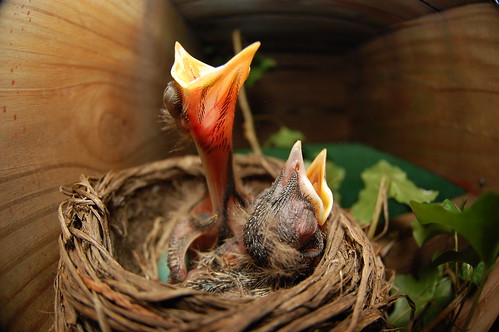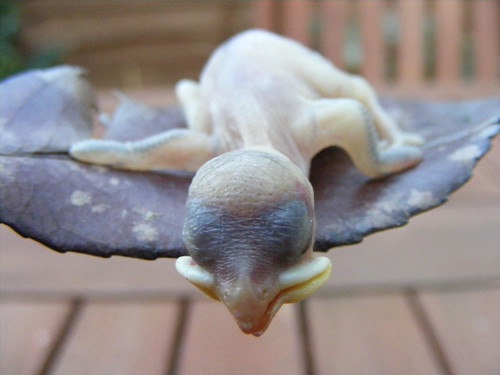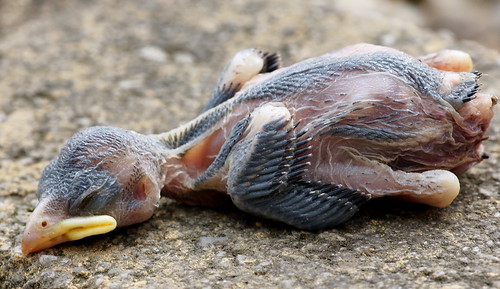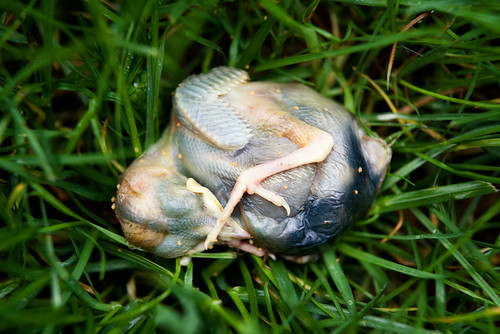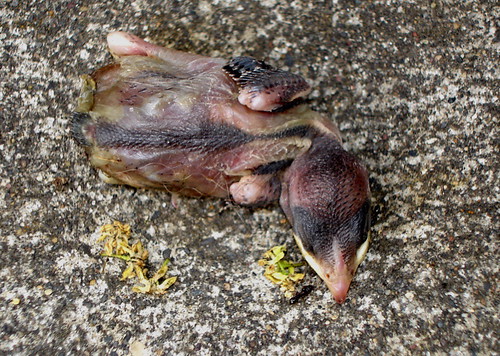Summer Solstice – Strawberry Rose Moon
by angeliska on June 26, 2013
Hot on the heels of the Summer Solstice, the full moon in Capricorn has waxed gravid over the horizon – a supermoon to boot, pregnant with all the intensity and magic of a grand water trine (Sun in Cancer, Saturn in Scorpio and Neptune in Pisces). The Algonquin tribes called the June full moon the Strawberry Moon, because this is the month when the ripening fruit can be harvested. (My own ripe strawberries have all been harvested prematurely by some vermin bandits, alas!) In Europe (where strawberries aren’t native), the June moon is known as the Rose Moon.
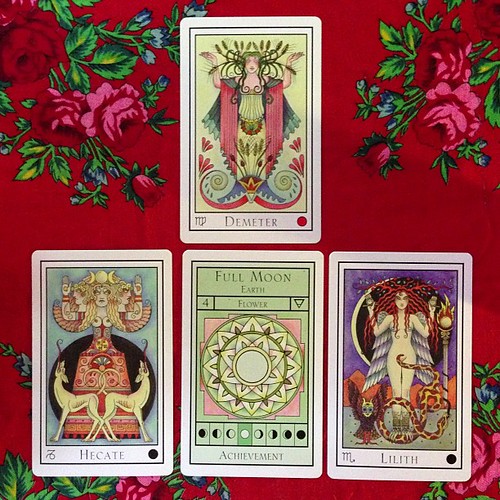
Hecate, Lilith & Demeter: powerful cthonic goddesses to guide us on this earthy full moon.

Solstice altar in the tarot trailer

Miss Allyson Garro in her solstice head-dressed glory, welcoming in the summer… All hail the Queen of Summer!
We went out in a wonderful canoe for the Summer Solstice Lantern Parade, and were serenaded from our serene vantage point on the water by Minor Mishap Marching Band. Out in the middle of the lake, I gazed at the pearly moon reflected in the water, all bright mercury slipping over my oars, and made wishes to help me be in the present moment, savoring every second of the now. This is something I’ve always had a hard time doing, but I realize that truly, the now is all that is, all we have. I want to make it count. Dusky blue herons burst forth from a copse of overhanging willows, rousing me from my reverie and bringing me back to the moment, the now, the now, the now…
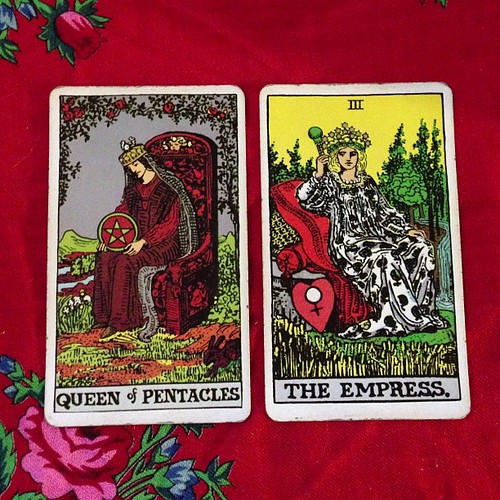
Queen of Pentacles + The Empress – channeling their abundance, creativity, stability, and sweetness on this full moon in Capricorn.
This is a time of abundance, of summer’s brilliant zenith, where the bounty of fruits and flowers brings sweetness to our eyes, our tongues, our noses. Honeysuckle and passionflower twine in my garden, and this year I harvested ripe plums and nectarines from the fruit trees planted years ago. The Queen of Pentacles and the Empress both remind us to plant those seeds, to nurture the things we want to flourish in our gardens, and to weed out what we don’t. These powerful archetypes both represent the Earth Mother, the divine feminine force, the ultimate Creatrix – manifested both on the celestial plane and on the earthly. These energies can inspire us to be independent, strong, and peaceful in the homes and workspaces we create for ourselves. To know and trust completely that we can provide for ourselves (and our children, if we have them). Think of the deep pride you might feel in being able to bring home your own bacon, in tenderly feeding your hungry baby bird (be it yourself or another), in maintaining a tranquil and beautiful place to live. This is a good time to take care of yourself, of your body – to cook good food that you grew yourself. This is strong magic.

Pre-solstice parade happiness. It’s crazy, you know – I’ve been realizing that it’s been almost a year since my life fell apart, and I couldn’t imagine then that I could ever really be happy again. So much has changed in my life, and yet the constants are a comfort. I have come through the slaughter, still remembering how to smile. Last year’s Full Moon in Capricorn was not so kind to me, and I’m grateful to report that this year’s has been far more gentle. To me, at least – though so many people I love dearly are having a really hard time right now. I’m focusing on sending them strength, and the knowledge that a year can change a lot of things.
This was last year’s moon: FULL MOON IN CAPRICORN

I made this full moon goddess ring as a gift for my stepmama! She has a carved bone luna face, made from sterling silver, with copper crescents.
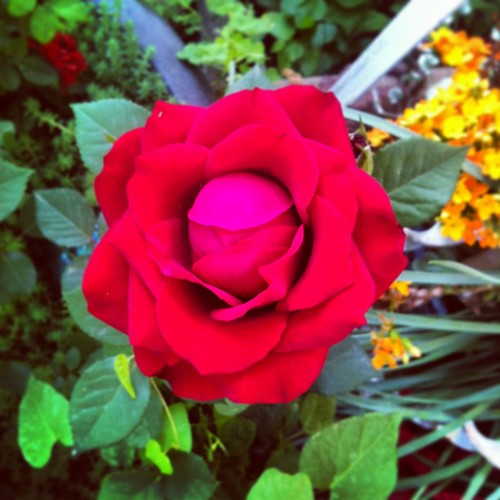
A perfect red rose, growing in my garden.
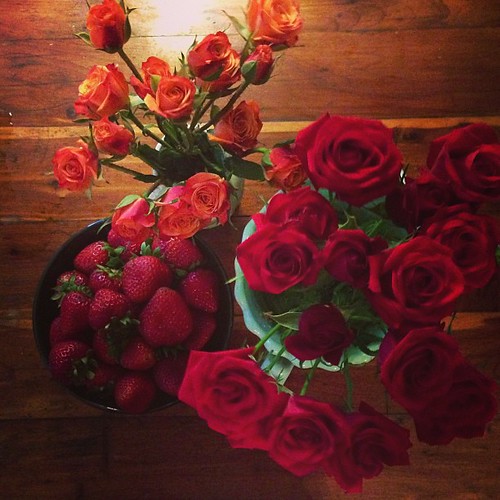
Happy Strawberry Rose Full Moon in Capricorn!
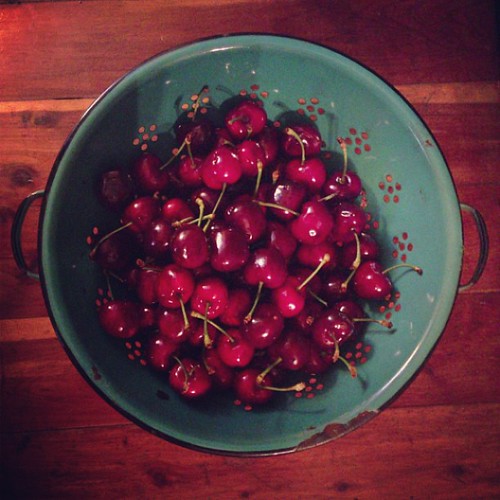
Life certainly is feeling like a bowl of cherries today – I got completely distracted from posting this earlier this week as I’ve been captivated by the goings-on in our State Capitol this week. Last night’s incredible feat of filibustering and explosive energy from the democratic politicians here in Texas, who were joined by the fired up citizens of Austin when they showed up in droves at the dome to shut down Senate Bill 5, and roar that we will not stand meek in the face of the GOP’s dirty war against women. Talk about Queen of Pentacles and Empress energy! Senator Wendy Davis of Fort Worth, Texas instantly became the hero of so many of us here in a state that is all too often seen as nothing more than a hateful backwater filled with hicks and idiots. She is the ultimate fierce warrior queen defending our constitutional rights with her strength, bravery and grace (and fabulous hair!). Huge love to Senator Leticia Van De Putte also for her huge heart and hard work, standing up to her male colleagues and making her voice heard. Not only that, but upon waking we discovered that not only had SB5 been defeated, but that also that the Defense of Marriage Act had been killed! Today is a great day for equality, and for activism – and this is only the beginning of the fight. Stay strong, stalwart sisters! Savor the sweet fruits of your labors, and the taste of victory!

Biggest home grown nectarine yet…
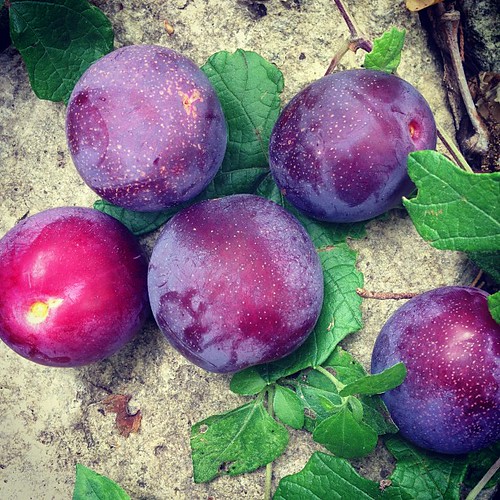
The plum tree planted seven years ago finally decided to bear fruit! They are incredibly juicy and delicious! So excited about this development.

A bouquet from my garden: Violet’s dead baby girl roses, black & blue sage, Queen Anne’s lace.
I hope your Summer Solstice, and the recent full moon has been treating you kindly, and that your life is full of sweetness, and that all the good things that you are working on come to fruition. What did you do to celebrate? What seeds are you planting for the future?
Here’s some more inspiration regarding moons, strawberries, and some May Queens thrown in for good measure:
STRAWBERRY HONEY
Full Strawberry Moon
FULL MOON “SuperMoon” in Capricorn June 23rd, 2013
May Queens at the Last Possible Minute
from Austin perfumista Alyssa Harad
And, some Summer solstices of yore:
SUMMER SOLSTICE – IF WISHES WERE HORSES
SUMMER SOLSTICE – A LUSH GREEN WISH
SUMMER SOLSTICE – POPPYTIME
MIDSOMMERVISE FOR MIN FAR
THE QUEERBOMB IS READY TO BLOW!
by angeliska on May 31, 2013
It’s Queerbomb time in Austin again, sweethearts! We’re getting ready to flood the streets with beautiful, proud happy queers and queens letting their freaks flags fly gaily in the summer wind, and if you’re in Texas, I hope you’ll come be a part of the magic this year.
What is Queerbomb?
Queerbomb is a Political Rally and Procession. Queerbomb is free to the public. Queerbomb is 100% free from corporate sponsorship. Queerbomb is an all ages event. Queerbomb is all inclusive.
Each June, the month of Stonewall, we stand together to embrace our sexuality, bodies, personalities, art, music, literature and politics, while recapturing pride from corporate sponsorship. We strive for a pride that refuses to put rules on what you can and can’t be proud of, that says every expression, from the spirit to the flesh, is worthy.
To give you an idea of what Queerbomb is like (if you don’t already know!) here are my photos from last year’s event:
See the full set of photos here: QUEERBOMB 2012
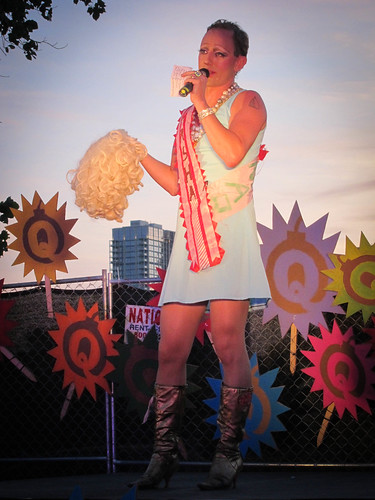
Paul Soileau (aka. Rebecca Havemeyer) leading the children
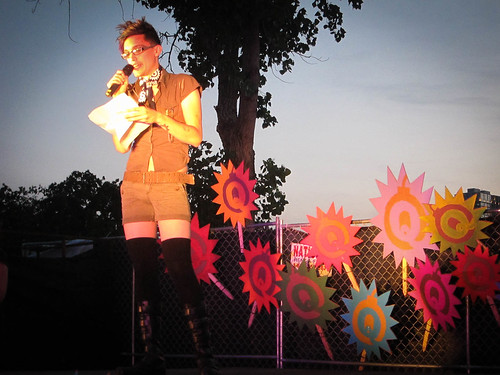
Sym Prole made our hearts swell with his powerful speech.
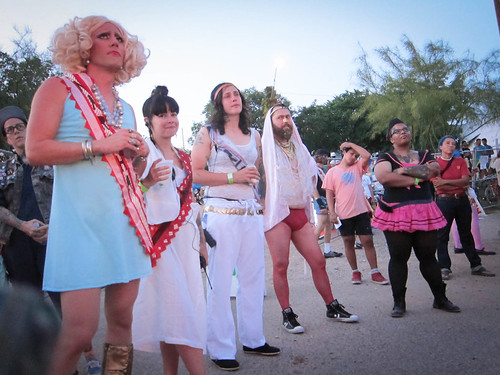
These are some of the wonderful people who make Queerbomb happen every year!

Silky Shoemaker

Bobby Johns
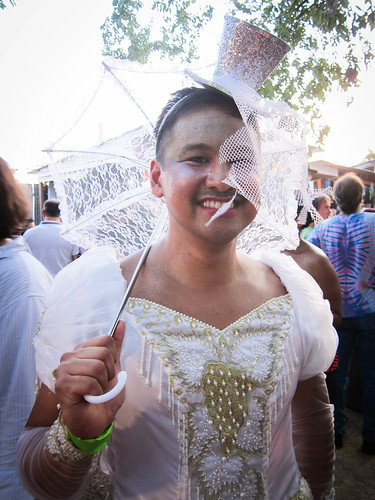
Blushing bride!
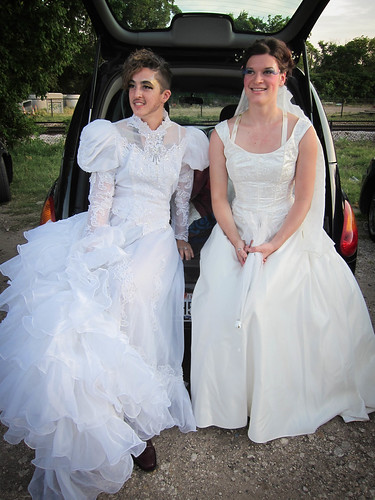
More blushing brides!
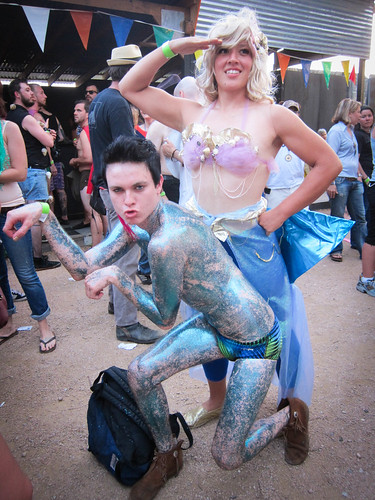
Mermaid people!
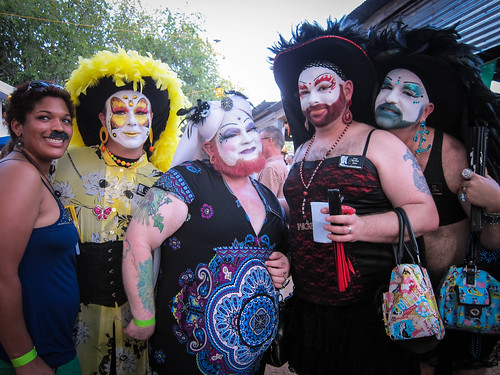
The Sisters of Perpetual Indulgence – Dallas Chapter
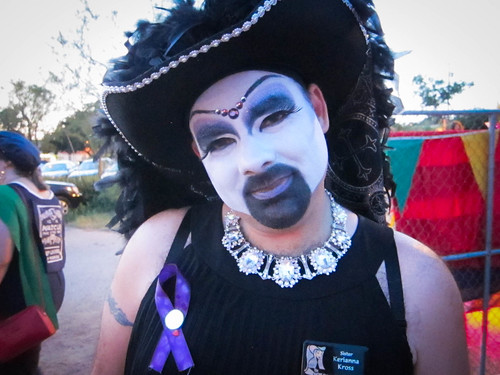
Sister Kerianna Kross

Sister MaeLynn Hanzment, Mistress of Habits, Founder and Sister Joslin M’Junk

Beautiful faces watching the rally

Tamicka shows her Queerbomb Pride!
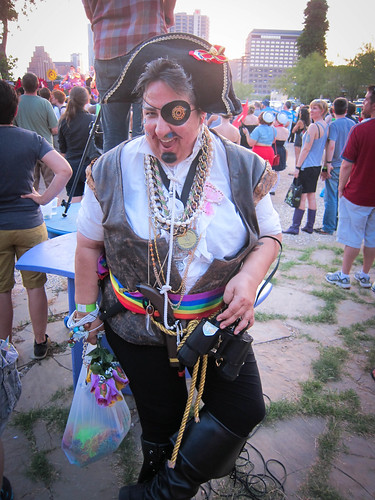
Dandy Unicorn!
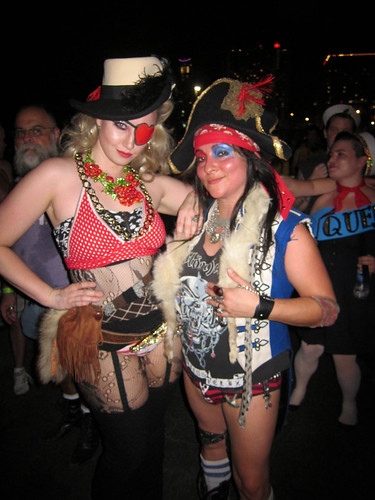
Kitty and Gina
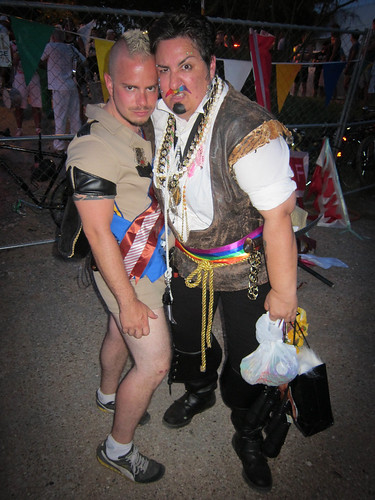
Matt Korn + Kate X Messer
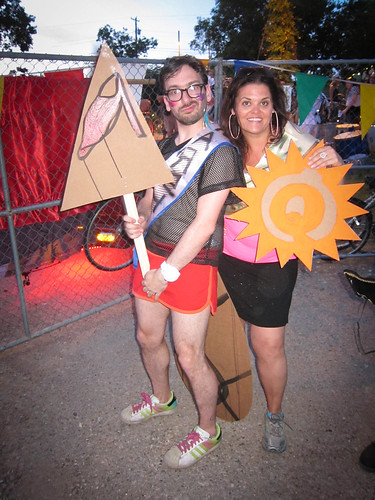
Andy Campbell and Claudette Murphy
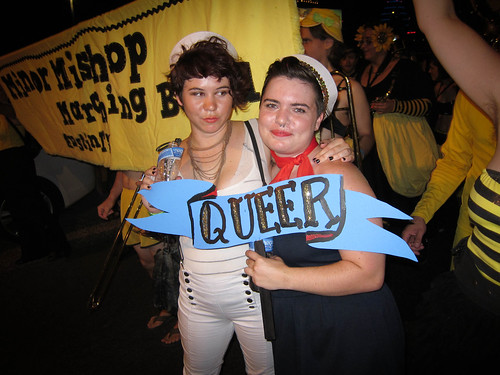
Maybe the best rally sign ever. Definitely. Sailor babes!
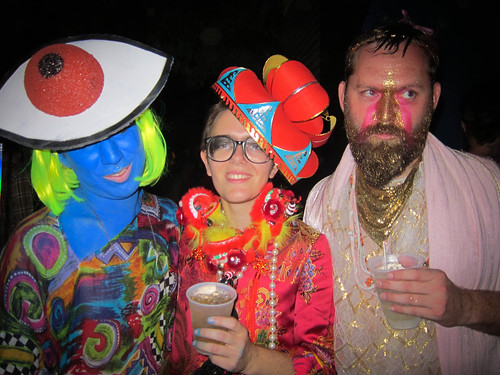
Jacob Wilson, Aaron Flynn, Billy Beasty = genius wizards, all three.
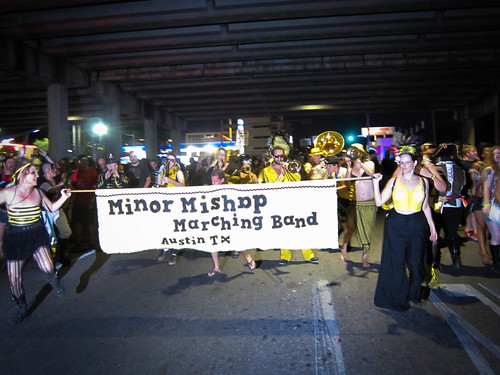
Minor Mishap Marching Band makes the Queerbomb procession a magical experience every year!

Magical unicorn puppet made by Aaron Flynn
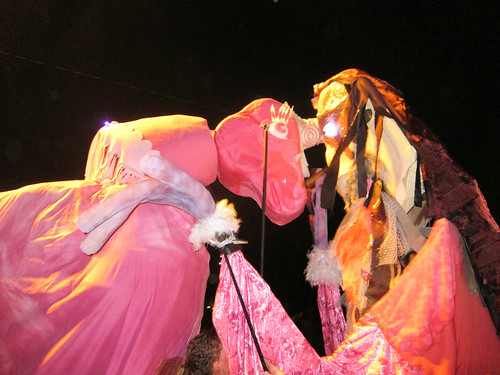
Unicorn, meet Hibiscus!
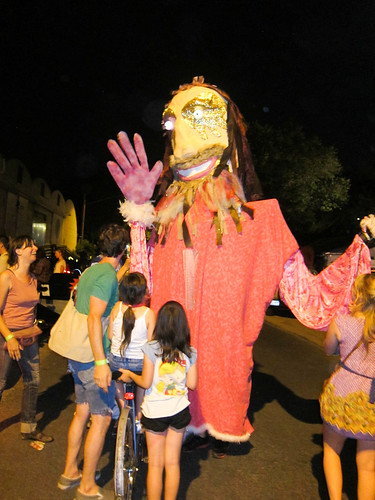
Everyone loves Hibiscus! The giant walking puppet was inspired by Hibiscus of The Cockettes.

Hibiscus + Jason Fialkoff
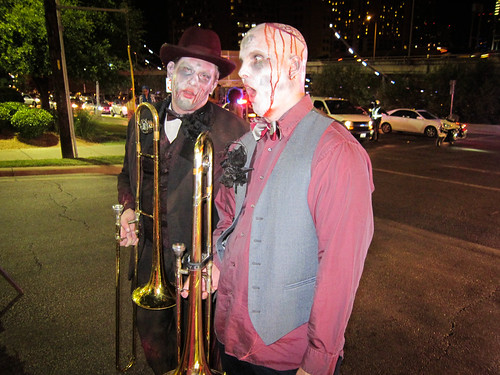
Zombie musicians from the awesome Dead Music Capital Band
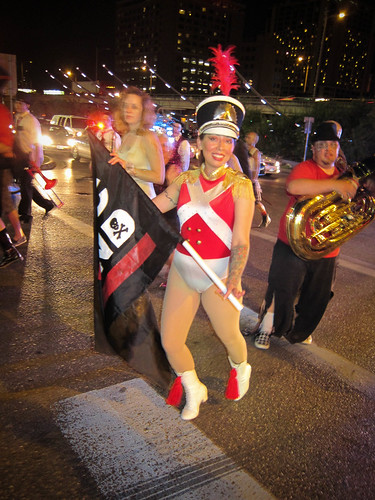
Forward march!

Puppies!
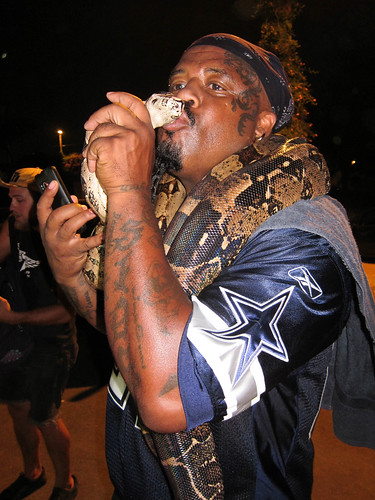
This guy was really sweet, and let me hold his giant snake!
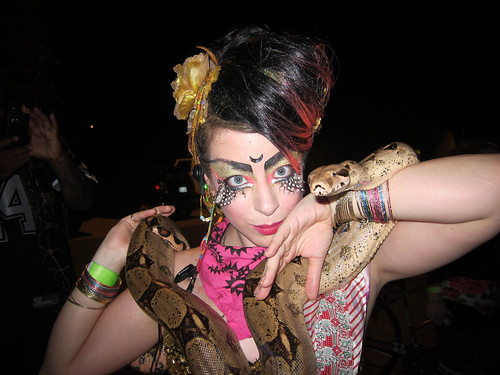
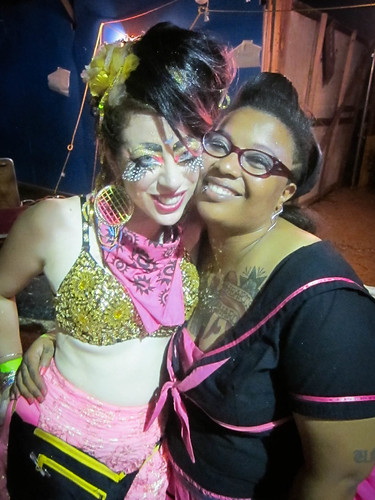
I love Tamicka!
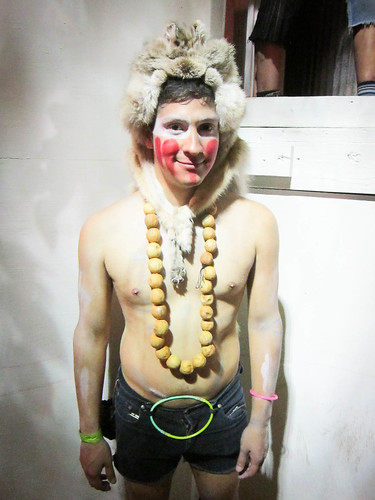
I love Julian, too.

WERQ!

I forgot your name, but I love you too.

Whip it! Into shape!
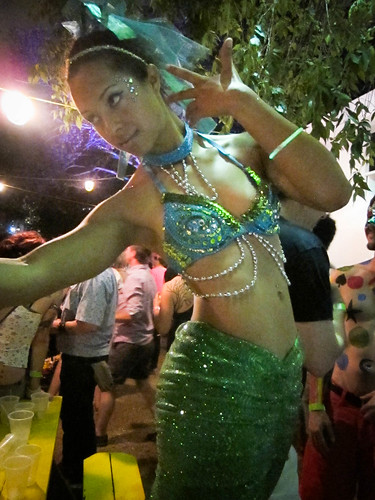
Yasi Mermaid enchants and entrances
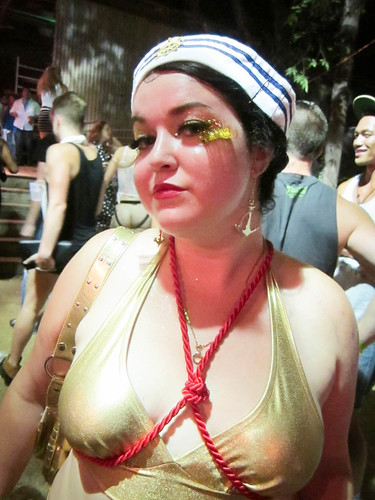
Olga Paley, won’t you show me some of your rope tricks?

Kate + Marley, oh my…
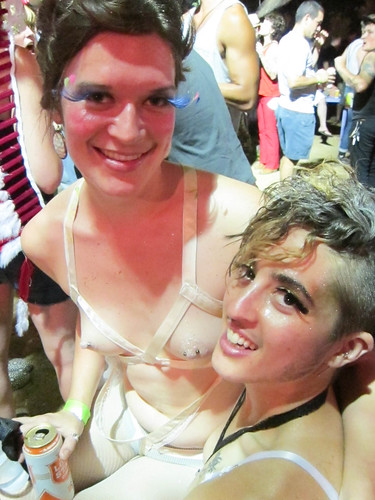
Myn of Satin, after having ditched their bridal gowns!
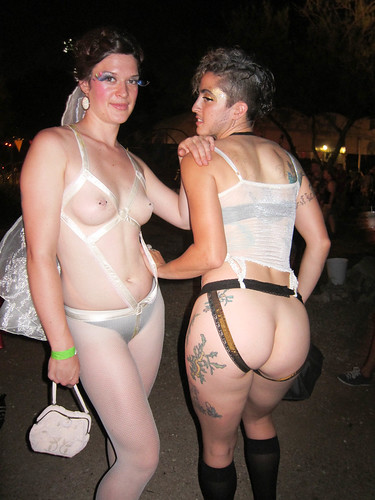
The end! And how!
Check out the magic from Queerbombs of yore:
QUEERBOMB IS COMING!
QUEERBOMB 2011!
QUEERBOMB!
QUEERBOMB MAGIC 2010
FLEDGLING HEART
by angeliska on May 21, 2013
It’s springtime here, and there are lots of baby birds hatching out of their eggs, nestled in the crooks of trees. Wee little hungry things, with gaping maws squawking constantly for sustenance. So delicate, so needy. When I’m having trouble loving myself, or being kind to myself – I think of those little birds, and of this passage from passage from Pema Chödrön’s book, The Places That Scare You – A Guide to Fearlessness in Difficult Times:
For an aspiring bodhisattva, the essential practice is to cultivate maitri. In the Shambala teachings this is called “placing our fearful mind in the cradle of loving-kindness.” Another image of maitri or loving-kindness is that of a mother bird who protects and cares for her young until they are strong enough to fly away.
People sometimes ask, “Who am I in this image – the mother or the chicks?” The answer is we’re both: both the loving mother and those ugly little chicks. It´s easy to identify with the babies – blind, raw, and desperate for attention. We are a poignant mixture of something that isn´t all that beautiful and yet is dearly loved.
Whether this is our attitude towards ourselves, or our attitude towards others, it is the key to learning how to love. We stay with ourselves and others when we’re screaming for food and have no feathers and also when we are more grown up and more cute by worldly standards.
Cultivating loving kindness and unconditional love towards ourselves is really about seeing the ugliest, neediest, most pitiful parts of ourselves – and tending to them with tenderness and support, rather than harsh judgment and self-cruelty. That is the work I come to in my journey of self love and reparenting, again and again.
If you know me, or if you’ve been reading what I write here for awhile, then you know that last year was a pretty traumatic one for me. As the months have passed since the emotional apocalypse of summer and autumn of 2012, I’ve found myself face to face with many hard lessons, many deep challenges. It is these experiences that temper us, that force us to reckon with ourselves, with our pain, our fears.
In the belly of the beast, there’s no more running – you either learn what you must, and grow, or keep running for the rest of your life. Or, as Pema puts it, “Do I prefer to grow up and relate to life directly, or do I choose to live and die in fear?” In the midst of all that, I just kept putting one foot in front of the other, taking care of myself, keeping myself going even when it seemed and felt impossible.
I remember so clearly, that feeling of going through the motions – the hollowness that was with me every day, that seemed like it had become a horribly permanent part of me. I called my dear friend Brett, who has been my sherpa up and down this terrible mountain, having traversed it a few steps ahead of me – I asked him, “When will this hurt go away? Does it ever fade?” He promised me that it did, eventually. I had to trust him on that one, and just keep moving forward. Thankfully, he was right.
You hold an absence
at your center,
as if it were a life.
– Richard Brostoff
(from “Grief”)
At some point I discovered that I was no longer merely just going through the motions – my life had changed, had been irrevocably altered, and I had found a way to accept and flow with those changes, as difficult and painful as they were (and often still are.) For the first time in months, when someone would ask me how I was, I could honestly answer, “I’m doing pretty good, actually…” It was an amazing feeling, to be able to say that, and realize that it was true.
Slowly, slowly, my heart had knitted itself back together. It was like the first drops of rain on parched earth after a long and brutal drought. Little green tendrils unfurled and began to reach out shyly, to climb and twine around – exploring this unknown territory. The healing took place almost invisibly, and so in some ways, I think I took it for granted. I was so used to being miserable and in pain for so long, that the day things started to ease up and turn around, I found it tempting to plunge headlong into just feeling good, into being okay.
I met someone, and fell in love – something I had imagined was impossible, unfeasible, or at least – highly unlikely. I was terrified to extend myself, to try and learn how to trust again, to believe in the possibility of love. It was scary, but also exhilarating – like I imagine learning how to ice skate might be. I’ve never tried it, but I imagine that I would be mostly not very graceful, wobbly like Bambi, falling over – hopefully laughing, hopefully not breaking anything.
One day, (on the morning of the explosive full moon in Libra back in March) we had a… I don’t even know what it was – cataclysm of sorts? I didn’t take it so well. In fact, I freaked out pretty badly. In an instant, the happy bubble of contentment I’d constructed was suddenly burst, and I tumbled out onto the hard ground. My reaction was shocking – especially to myself.
I thought I had been doing such a good job of nurturing myself, healing myself, being patient and kind to myself – and yet, here I was right back in that dark pit of despair and self-recrimination. In a flash, all the work I’d done on having a good and loving relationship with myself seemed to evaporate like dew on a hot day – I felt rejected and thrown away, a feeling that has been a recurring theme I’ve battled a lot in my life, but particularly often this year.
Instead of lashing outward (okay, mostly), I lashed inward – I was literally slapping myself in the face over and over, calling myself stupid. Stupid for loving, for trusting, for believing that things could be good, that I could have love. I was so angry at myself for allowing myself to be so vulnerable again, for being so raw, for letting myself get hurt. I realized that I was still not fully healed, too unsteady and new to all this, too prone to mistakes.
Instead of being gentle and kind to myself on that hard day, I was very mean indeed. I was impatient, infuriated and embarrassed that I could be back in this state of deep pain. All of a sudden, I was the baby bird again, falling out of the nest. I thought I had grown, my fine feathers had come in finally and I imagined that I could fly – but no. Instead I toed that helpless lumpen bit with my boot, and kicked it over into the grass for the mercilessly biting red fire-ants of self-loathing to torture and devour.
You know, baby birds are really ugly. They’re actually hideous: half-blind squinty eyes in purple sockets that look like a boxer’s swollen shiners, that translucent, testicular skin stubbled with needle-like feathers poking through, their gaping yellow maws squawking unceasingly for food. “I want! I want! I hurt! I hurt!” So hungry, so needy, so pathetic. And yet, like Pema says – their mamas love them dearly, unconditionally, without reserve or judgement for their babies’ outcast state, their bootless cries. The mamas are there, protecting, feeding, comforting.
As children, of course we look to our mothers to do this for us, or sometimes our fathers too – but as adults, most of us never learn to do it for ourselves. It’s hard, when you’re nothing but a splattered mess on the asphalt, to pick yourself back up, and tenderly cradle that ugly part of yourself. To feel compassion for your flaws, your weaknesses – instead of disgust and shame.
How can we allow ourselves to be the tiny nestling, and rise up to being the capable adult, simultaneously? That’s the trick – that is the work. Being totally present with ourselves in that raw and frantic place is usually too overwhelming, too awful – we reach immediately for distraction, for panacea, for something that will make that noisy and annoyingly achy part of ourselves shut the hell up.
Whatever the thing is that usually seems to work for us, be it booze, drugs, sex, shopping, television, work – it’s only a temporary fix. The unhappy baby bird is only going to be satisfied by one thing: love. I think I did grasp that part pretty early on, after I lost my mother – that the only replacement for her unconditional mother’s love, was what I learned from fairytales was the next best thing as far as depth and enduring power went: true love, romantic love. Prince Charming, the knight in shining armor, the soulmate, The One.
I spent years looking for that elusive concept in all the wrong places, and damaging myself plenty on that thorny path. What I didn’t get, is that it’s not about finding love, about being loved – it’s about loving. My teacher reminded me of this recently, and also – that the majority of the great love songs, when you really listen to them, are about giving love – not receiving it. Of course, how can you give that love to others if you can’t extend it to yourself? It’s just like we’ve been told all our lives, and just like RuPaul says: “If you can’t love yourself, how the hell you gonna love somebody else?” Can I get an amen? It can sound like nothing but an easily cast off feel-good platitude, but that shit is true.
You have to be able to give it to yourself first. You have to be enough for yourself at all times. You have to be the one you are looking for. For years, I was like that little bird in the storybook, “Are You My Mother?” trying to find something or someone outside of myself to replace that love that I lost. I didn’t know that I had it in me all that long while – I didn’t know that I was enough.
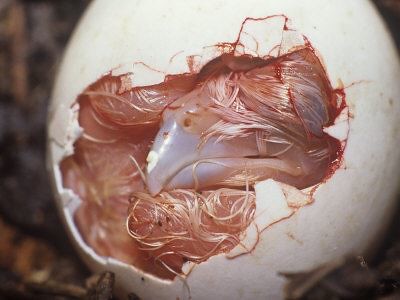
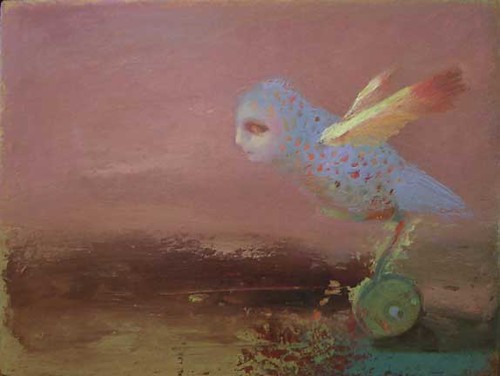
As painful as my recent tumble from the nest was, as excruciating as all of the hard experiences in my life have been, I am finally starting to feel grateful for them – grateful at least for the lessons, for the opportunities to grow, to learn. As horrid as it was to be back in that shitty, broken place with myself, I eventually eased up. I let the tears fall, without furiously knuckling them away – I held myself, in all my heaviness, my rawness. I listened to my own piercing cries patiently, and tried not to recriminate myself for my sensitivities.
I’ve had to learn to be my own mother, my own true love, my own best friend. It sounds kind of lonely, kind of sad – to have to do that for yourself, maybe especially if you actually have a mother, a true love, a best friend. Isn’t that their job? To love you, to be there for you, to never leave you? Maybe so, but who knows if they can always be there, even if they wanted to be.
We have to be there for ourselves, first and foremost. Always. As an addendum to this story, you might want to know that the cataclysm that sparked it was relatively brief and peacefully resolved with a currently extremely happy outcome. That’s a good thing – but it’s a challenge to not fall back on a relationship to be the thing that fixes us, makes us feel safe, satisfied, whatever. It’s still up to us to maintain that baseline of self-care regardless of what anyone else in our lives is doing or not doing.
I had a powerful experience recently, on my family land: I was laying belly down on the sun-warmed outcropping of pink granite out past the creek, and had the intense sensation of being embraced, being held by the earth. Many times over the years, I’ve encountered well-meaning hippies, who, upon hearing that I lost my mother at a young age, would tell me, “Oh honey, you still have a mom! The EARTH is your mother!” I would sneer at them and explain that the earth wasn’t available to take me bra shopping, make me doll clothes, to teach me all the lady secrets I grew up having to guess at.
In this moment, though – I finally felt it, felt that it was true. The earth was cradling me like a little robin’s egg, like an infinitely precious treasure. Never in my whole life, outside of the womb, have I felt so loved, so protected, so cared for and adored. It was amazing – and I know that I was feeling my mother, my grandmother, my great-grandmother, all the women who lived and died on that ancestral land, reaching out to me through the rock.
I feel certain that being able to feel all that was a gift that I was able to receive because of how much I’ve been trying to understand this lesson. Knowing that I can reach within, and at any time, access that deep unconditional love is the greatest gift I could ever imagine. I have been looking for this answer for almost as long as I’ve been alive. It was here all the time. What if we could all hold that fullness, instead of an absence, at our centers – all of the time? As if it were a life. Because it is. Stretch out those fledgling wings, little thing.
What do you do if you find an actual baby bird fallen out of the nest? Here’s what.
Weird But True: The Secret to Dealing With Those Things Called “Feelings” – I stumbled across this post when I was researching writing this piece, and I’m so glad I did. There’s a really important story here, that I’ve been really impacted by. Please read.
The Gutting Board – An amazing piece by my sherpa, comrade, traveling companion and dear friend, Brett Caraway. I wrote this in part, as a response to his piece.
Are You My Mother?
Beltane Fire – Pink Moon
by angeliska on May 1, 2013
Calloo, callay, it’s May Day! I’ve been fighting off the annual Scorpio moon lethargy that apparently strikes me every year – strange but true, I find myself struggling to climb a seemingly endless mountain of correspondence, household chores, gardening et cetera and never seeming to make much progress in my Sisyphean toils! Finally, I just gave myself three days off to come back to myself, have some quiet time to hack away at my gargantuan to-do list and feel better in general about everything. I feel like I am finally emerging from the cocoon I enveloped myself in last year: a full cycle’s turning, and here I am, pumping blood into my sticky wings, preparing for flight. It’s taken some doing to pull the shreds of tattered chrysalis from my eyes, to shed my old skin – stubborn bits of shroud still cling to me here and there. I am trying to be more patient with myself, to give myself the time that I need to sit a breathe a bit, to unfurl slowly, to learn what this next chapter is all about. The recent Pink Moon waxed full on the 25th, and we honored it with a Beltaine bonfire, traditional spring songs and ritual. The past two full moons (in Libra and then in Scorpio) have cast a bright and discerning eye upon relationships and partners, old and new. I have learned more about myself and the way that I engage in my relationships in the past six months than I ever did in the past six years. Or, perhaps the learning was happening then too – building up layers of sedimentary understanding and awareness. I’m learning much from my mistakes. I won’t say any of it has been easy, but it has been enormously rewarding to put these lessons into practice and see them work. Last year’s Scorpio full moon was all about letting things go. I can stand back now, and see how hard that process was for me, how much I’ve had to let go of this year – and yet, now, I’ve come to have a modicum of peace, even for some of those more painful endings. I wasn’t sure how the eclipse and all the various intense celestial aspects would affect me personally, but was fairly relieved to have a bit of calm, a little room to breathe and grow in the wake of this stormy past year. And what’s more – what a wonder it is to have found some happiness there, as well. Beltane is a time of rejoicing, of celebrating – a time to take your lover by the hand and lead them out to the fields, out to the woods, to do “that which love commands”! I’ve been meditating much on two cards from the tarot that have come up a lot of me this year, and that are also associated with Beltane: the 4 of wands and The Lovers. The 4 of wands is a favorite cards of mine: it’s such a beautiful image of celebration, of what happens when you set your energy and passion forth to build a solid foundation for your projects and endeavors. This card is all about setting the table, building the altar, garlanding your life with flowers. It’s clearing off your desk and lighting candles in your studio. Creating a joyous and harmonious space to do the work you were meant to do. Without the stability of the four, wands fire energy can be ungrounded, formless, all talk – the four says, “I have arrived! I belong, and I’m here to stay (and celebrate!)”. It’s the wedding – whether between two lovers, or between you and your commitment to your passion, to whatever it is you love most – be it your work, your creative path, your home, community or family. In honor of this card, I finally cleaned up my absurdly messy house – I cleared the rooms, and burned sage and copal and rose petals. Making the space ready for good work to happen in! The Lovers card has been on the altar in my studio for a long time, and a few months ago, I almost took it down – deciding that I’d had enough of trying to figure out this card in my own personal life. The universe had other plans for me, and I’m still here grappling with that eternal question: the union of opposites, the alchemical marriage, learning what the dualities have to teach each other in that cosmic, tantric firework-sparkling explosion of pheromones and spirit. Turns out it’s not as simple as I once thought – no surprise that humans have been trying to figure out what this love thing is for centuries, and perhaps are no closer to having any real answers… Though I will say this – I have learned more about love and relationships (not just romantic ones, either) from my counselor and teacher, Jason Fischer. He wrote a book that came out a few months ago, that have been a major part of of me understanding so much better how to make my relationships a lot less painful and a lot more extraordinary.
I highly recommend spending some time with this one if you’ve got questions about love and relationships: The Two Truths about Love: The Art and Wisdom of Extraordinary Relationships
Also, in the spirit of that sexy (now waning) full moon, and this fertile and lusty love festival, a beautiful love letter from Henry Miller to Anais Nin, showing us how it’s done: Now that is how you write a Love Letter

“Full Pink Moon – April This name came from the herb moss pink, or wild ground phlox, which is one of the earliest widespread flowers of the spring. Other names for this month’s celestial body include the Full Sprouting Grass Moon, the Egg Moon, and among coastal tribes the Full Fish Moon, because this was the time that the shad swam upstream to spawn.” – from the Farmer’s Almanac
Some rundowns on the celestial significance of this Full Moon and eclipse, from a few of my favorite astrologer/writers:
Full Moon and Lunar Eclipse in Scorpio April 25th 2013 from the always wonderful Mystic Mamma
Lunar Eclipse in Scorpio – April 2013 – Testing Times from Leah Whitehorse, who is a brilliant.
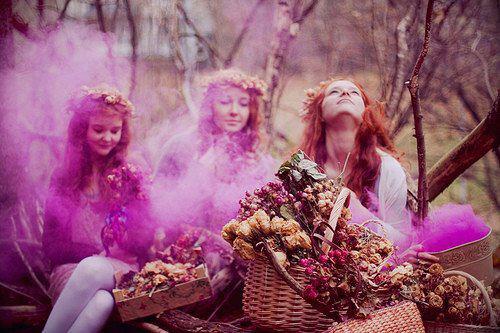
burn our souls, release the wicked VIII by Ailera Stone/Aistė Tiriūtė
Some history & lore of Beltane…
Beltane, and its counterpart Samhain, divide the year into its two primary seasons, winter (Dark Part) and summer (Light Part). As Samhain is about honoring Death, Beltane, its counter part, is about honoring Life. It is the time when the sun is fully released from his bondage of winter and able to rule over summer and life once again.
Beltane, like Samhain, is a time of “no time” when the veils between the two worlds are at their thinnest. No time is when the two worlds intermingle and unite and the magic abounds! It is the time when the Faeries return from their winter respite, carefree and full of faery mischief and faery delight. On the night before Beltane, in times past, folks would place rowan branches at their windows and doors for protection, many otherworldly occurrences could transpire during this time of “no time”. Traditionally on the Isle of Man, the youngest member of the family gathers primroses on the eve before Beltane and throws the flowers at the door of the home for protection. In Ireland it is believed that food left over from May Eve must not be eaten, but rather buried or left as an offering to the faery instead. Much like the tradition of leaving of whatever is not harvested from the fields on Samhain, food on the time of no time is treated with great care.
When the veils are so thin it is an extremely magical time, it is said that the Queen of the Faeries rides out on her white horse. Roving about on Beltane eve She will try to entice people away to the Faeryland. Legend has it that if you sit beneath a tree on Beltane night, you may see the Faery Queen or hear the sound of Her horse’s bells as She rides through the night. Legend says if you hide your face, She will pass you by but if you look at Her, She may choose you. There is a Scottish ballad of this called Thomas the Rhymer, in which Thomas chooses to go the Faeryland with the Queen and has not been seen since.
The beginning of summer heralds an important time, for the winter is a difficult journey and weariness and disheartenment set in, personally one is tired down to the soul. In times past the food stocks were low; variety was a distant memory. The drab non-color of winter’s end perfectly represents the dullness and fatigue that permeates on so many levels to this day. We need Beltane, as the earth needs the sun, for our very Spirit cries out for the renewal of summer jubilation.
Beltane marks that the winter’s journey has passed and summer has begun, it is a festival of rapturous gaiety as it joyfully heralds the arrival of summer in her full garb. Beltane, however, is still a precarious time, the crops are still very young and tender, susceptible to frost and blight. As was the way of ancient thought, the Wheel would not turn without human intervention. People did everything in their power to encourage the growth of the Sun and His light, for the Earth will not produce without the warm love of the strong Sun. Fires, celebration and rituals were an important part of the Beltane festivities, as to insure that the warmth of the Sun’s light would promote the fecundity of the earth.
Beltane marks the passage into the growing season, the immediate rousing of the earth from her gently awakening slumber, a time when the pleasures of the earth and self are fully awakened. It signals a time when the bounty of the earth will once again be had. May is a time when flowers bloom, trees are green and life has again returned from the barren landscape of winter, to the hope of bountiful harvests, not too far away, and the lighthearted bliss that only summer can bring.
Beltane translated means “fire of Bel” or “bright fire” – the “bale-fire”.
– from witchvox.com
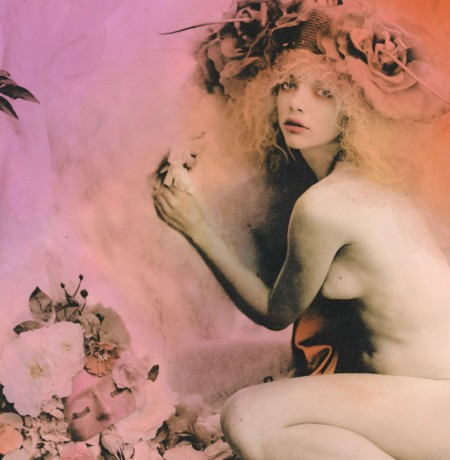
Chloe – Ellen Rogers I love Ellen’s work so, so much – she is magic.
One year, I hope to set up an actual Maypole for dancing around with ribbons, but until then singing around the bel-fire suffices nicely. We sang Hal-an-tow (the term “halan” means “calends,” or first of the month, and “tow” means “garland”.) and the Staines Morris song. Amy Annelle taught us the words and lead us in the singing of these sacred songs.
“The green calendar of spring has many songs. dances and shows, particularly around the opening days of May. Here and there are clear traces of old cults and superstitions (well-dressing against droughts, etc.) but generally their original meaning is lost. So the customs are transformed into ritual spectacles, festivities, distractions, opportunities for a good time, such as the old May Games that once comprised four sections: the election and procession of the May king and queen: a sword or Morris dance of disguised men; a hobby horse dance; a Robin Hood play. The Hal-an-Tow song was sung for the procession that ushered in the summer.”
– Hal-an-Tow
Hal-an-tow, jolly rumbalow
We were up long before the day-O
To welcome in the summer,
To welcome in the May-O
For summer is a-coming in
And winter’s gone away-O
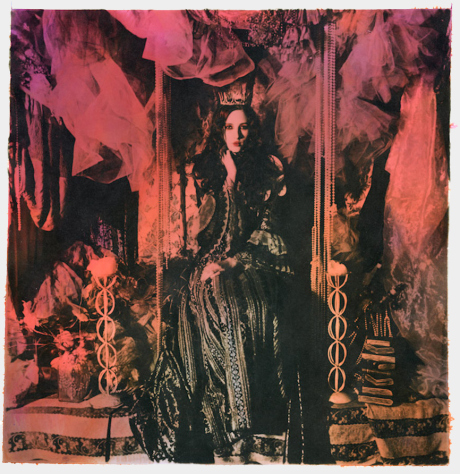
Hexes – Ellen Rogers
“Come ye young men, come along
With your music, dance and song
Bring your lasses in your hands
For tis that which love commands
Then to the Maypole haste away
For ’tis now our holiday
It is the choice time of the year
For the violets now appear
Now the rose receives its birth
And the pretty primrose decks the earth”
– Staines Morris Dance
– Shirley Collins – Staines Morris

Wonderland : The Pink Saint by Kirsty Mitchell
“Kirsty Mitchell’s late mother Maureen was an English teacher who spent her life inspiring generations of children with imaginative stories and plays. Following Maureen’s death from a brain tumour in 2008, Kirsty channelled her grief into her passion for photography. She retreated behind the lens of her camera and created Wonderland, an ethereal fantasy world. The photographic series began as a small summer project but grew into an inspirational creative journey.’Real life became a difficult place to deal with, and I found myself retreating further into an alternative existence through the portal of my camera,’ said the artist.”
– Woman, 36, who lost mother to brain cancer creates breathtaking fantasy land photo series in her memory
These two images call up the Queen of May for me, the priestess of all that is blossoming, and the wildness of sap rising, Persephone returned to the garden after months int he underworld.
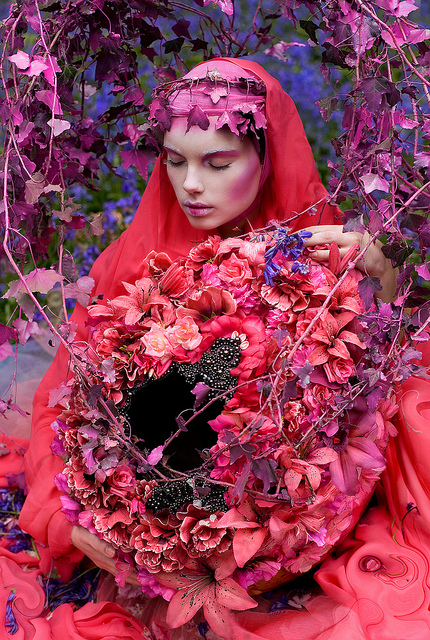
Wonderland : The Beautiful Blindness of Devotion by Kirsty Mitchell

Richard Mosse: Falk Visiting Artist
I love this image of the Congo hills made pepto-bismol – Mosse’s work is really amazing:
“Irish photographer Richard Mosse is known for his restraining and highly aestheticised views of sites associated with violence and fear, such as his 2008 depictions of the war in Iraq, and his large-scale photographs of aeroplane crash sites. For his new series, Infra, Mosse used Kodak Aerochrome – an infra-red film designed in the 1940s to assist the U.S. military in detecting camouflage – to photograph the people and landscape of the Eastern Congo. The film reveals a spectrum of light beyond what the human eye can perceive, turning the lush, green landscape of the Congo into a bubblegum pink. The photographs investigate the severe circumstances within which the people of the Eastern Congo live and draw our attention to the complex social and political dynamics of this region of the world.”
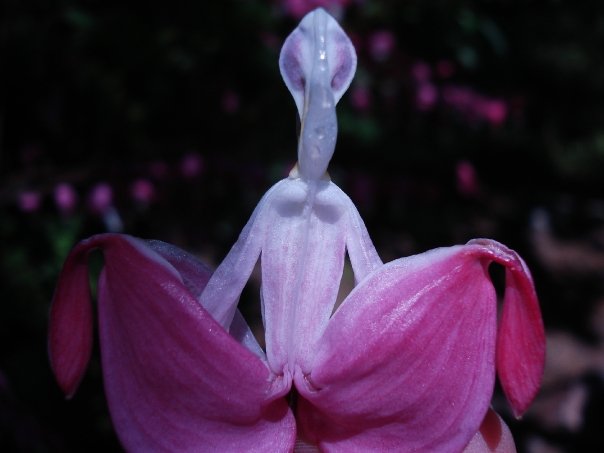
The Bleeding Heart Flower Spirit
Who knew that inside this flower exists a magical being? Well, now you know!
My friend Lily Rose Love wrote this today, and it was too wonderful not to share here:
“On May first when I was a little girl my folks and I would make up baskets and baskets – lots of little baskets of flowers and drive the seven miles into town to surprise old ladies. I don’t know if they made up this tradition, or if anyone else did this, but we would go up to the houses where we knew little old ladies lived all by themselves, leave the bouquets on the porch or hanging from the doorknob, ring the bell, and then run and hide in the bushes. Sometimes they were confused, sometimes they seemed to be expecting it, but they were always so happy and all smiles when my dad and I popped up out of their hedges with our matching blonde curls. Happy May Day.”
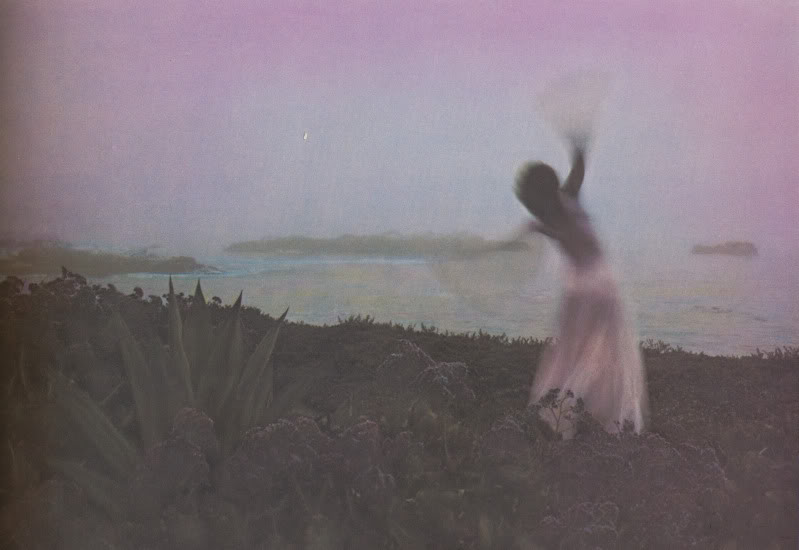
Gail Skoff, Ann, 1974. – found via my beloved Mlle. Helms at sighsandwhispers
Dance in the gardens, lovelies. Hop over the bonfire and make a bright wish. Take your lover by the hand.
Here are a few choice soundtracks for doing just that:
Beltanes and moons of yore:
FULL MOON IN SCORPIO
FLORALIA
LA REINE MASQUÉE DE MAI
Gay Bi Gay Gay
by angeliska on March 17, 2013
It’s that time of year again: spring is in the air, and my house is packed to the brim with lovely vagabonds sprawled out on every bit of available floorspace. In Austin, the second week of March heralds the invasion of our fair city by thousands of tech geeks, filmmakers, musicians and everyone in between for a couple weeks of concentrated over-stimulation otherwise known as SXSW. More and more, I find myself saturated with all the excitement and entertainment I require by spending time with my overflowing house full of friends visiting from near and far, and have come to shun the crowds, lines and general chaos that reigns downtown. The truth is, the only part of this whole thing I really care about is Gay Bi Gay Gay, and a large part of that is because it’s its own thing: a strange mushroom that sprang up on the outskirts of the garden – phosphorescently glowing and glimmering with fairy lights. If that sounds slightly hyperbolic, you’ll have to excuse me, but I really do regard this day as sacred in Austin. It’s part family reunion, part picnic, part performance art camp, part music festival – but more than anything, it’s a magical day where the joy and relief and sweetness in the air are palpable. Everyone’s faces get so radiant, so ecstatically happy just to be together again. In a lot of ways, Gay Bi Gay Gay is the closest thing that Austin has to Mardi Gras day. Looking over these pictures for the first time in a few years takes me back. I always love photographing duos, or couples, and I realized that a lot of these relationships are no longer extant today, including my own. But some are. Hopefully the friendships and goodwill have survived, because you can see the love in these images, in these faces. My GBGG tradition involves decadent picnicking, homemade Bloody Marys, and copious face-painting! I find doing elaborate macquillage to be extremely meditative and relaxing, and I was honored to do Big Freedia’s stage makeup that year, as well as decorating the lovely mugs of some of my favorite folks. Evidence of big queer love, serious ass-shakin’, and major magic follows below…
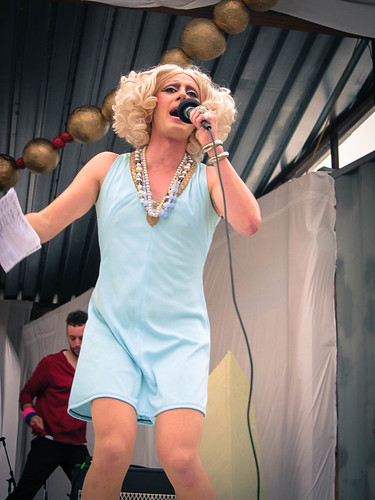
Rebecca Havemeyer
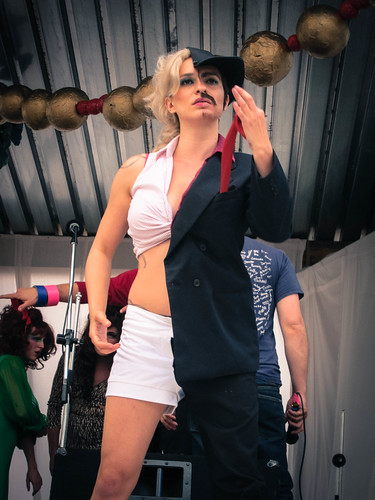
Raven
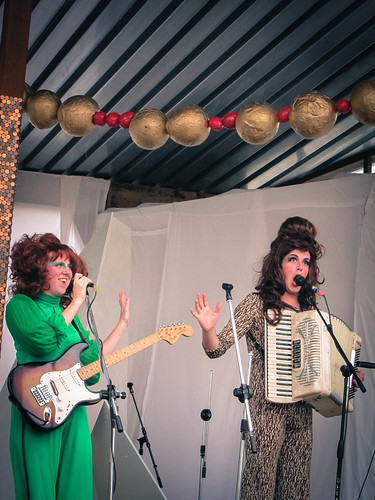
I forget who these guys were! But they were really funny!
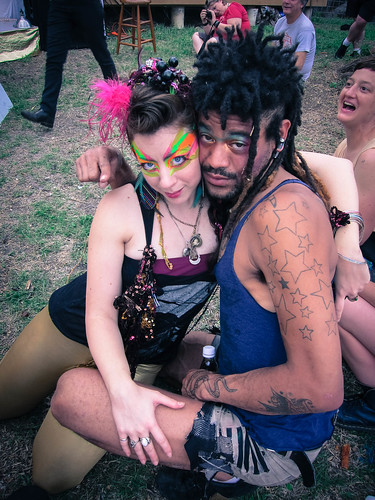
Me and Lester
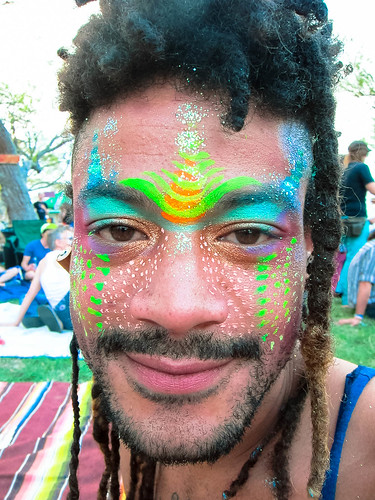
Lester
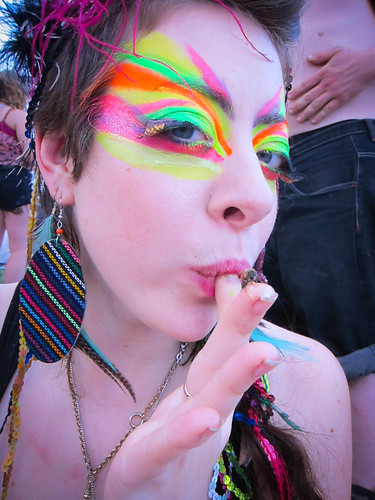
I found pie, and then a little bee found me. She wouldn’t leave my finger for the longest time…
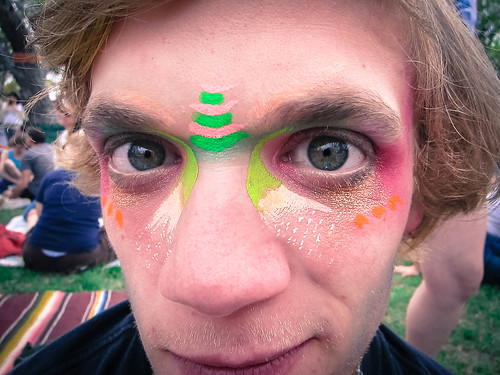
Frank of Jean Eric

Rach Huck

Sassy Delure
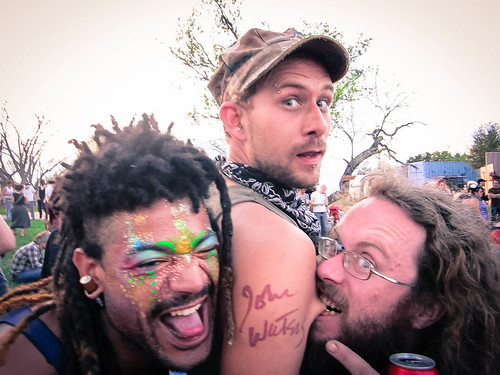
Release the bats! BITE!

Erica Nix
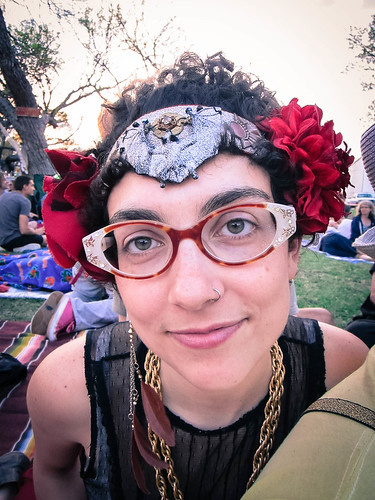
Corinne Loperfido

Big Freedia the Queen Diva
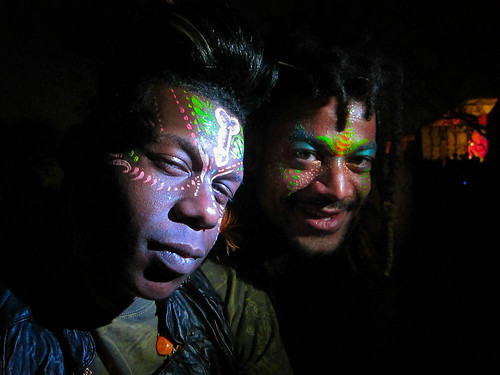
Freedia + Lester
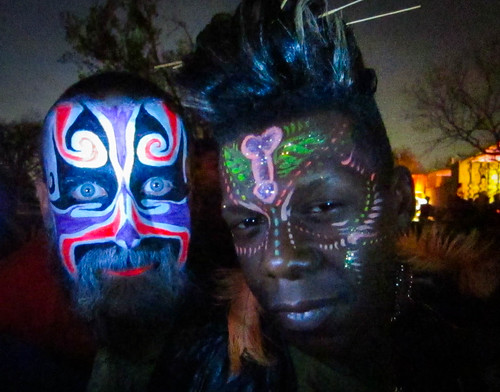
Colin + Freedia
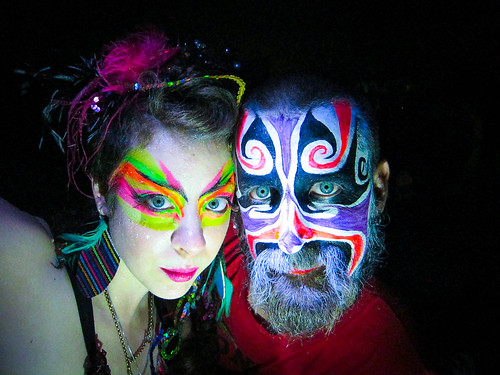
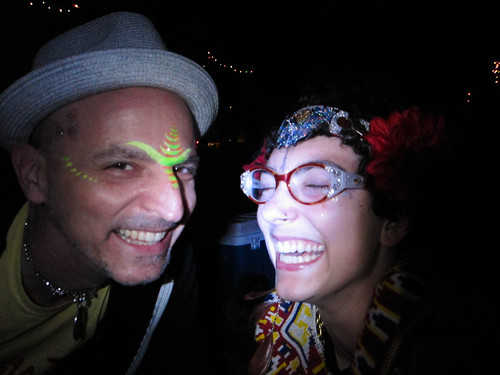
Rusty + Corinne
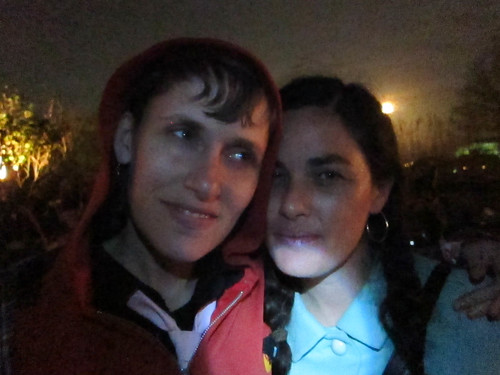
Lisa + Sienna
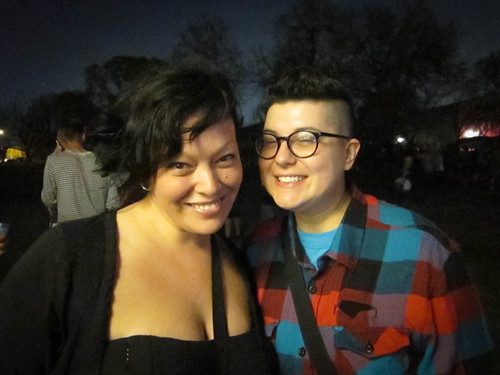
Cuppy + Ruthie
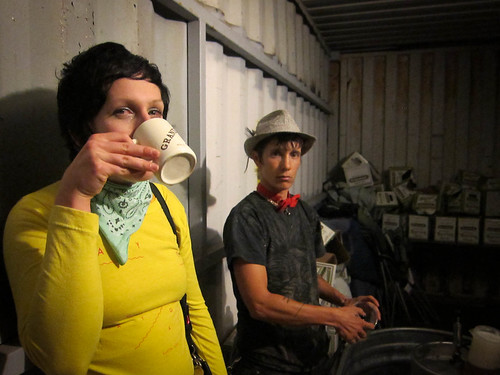
Maia + Eli
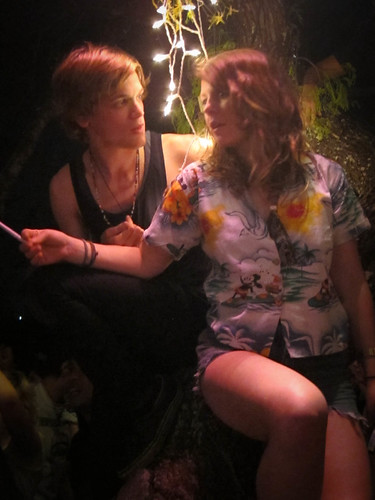
Franks + Karen of Jean Eric
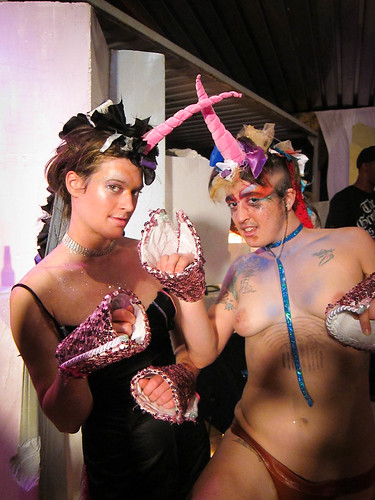
Unicorns!

Bobby Johns
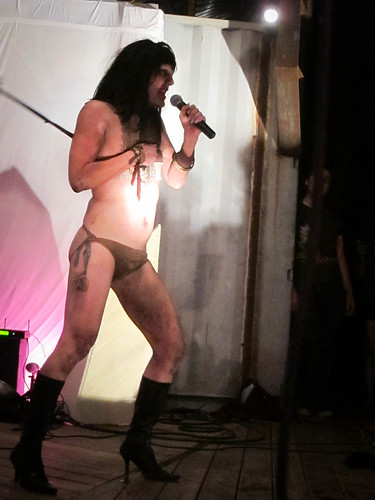
Christeene
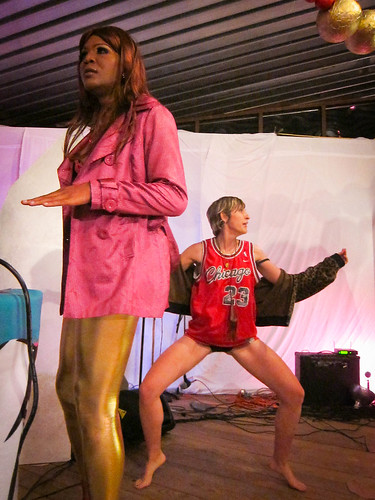
Katey Red + Melissa McWilliams
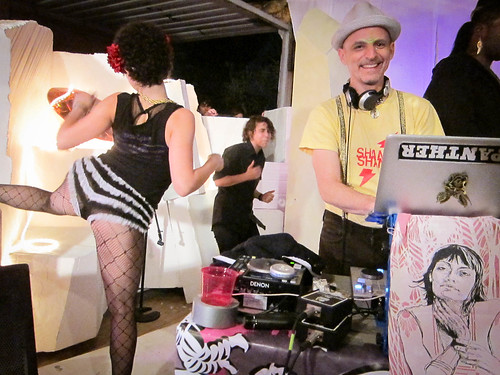
Rusty + Corinne
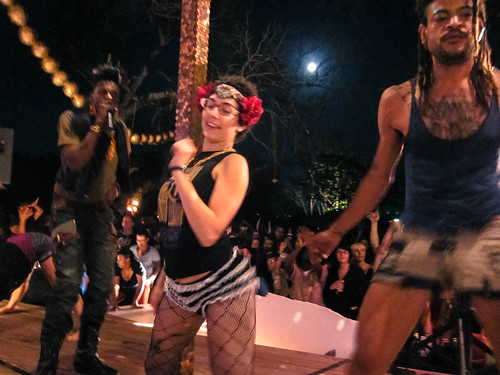
Shakin’ it for Freedia

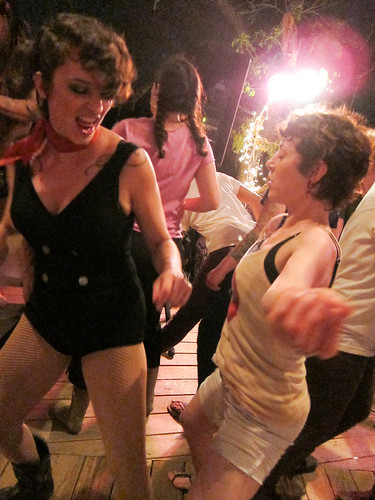
Raven + Francesca

Lester
The full set of photos is here: GAY BI GAY GAY 2011
And more, from The Gay PlaceGay Place: Gay Bi Gay Gay Day
Here’s the piece I wrote about GBGG that I wrote for Coilhouse a few years back:
Gay Bi Gay Gay
And some articles about this year’s Gay Bi:
from The Austin Chronicle – The Gay Place: Family Tradition – The fall and rise of Gaybigaygay
GayBiGayGay Line-Up Announced! Here’s what we know about the line-up at the annual free post-SX gay fest
Goodbye, Charlie
by angeliska on February 27, 2013
One year ago today, my Grampa left this world. I’ve been crying uncontrollably for the past couple of days – for various reasons, but mostly it’s because I just feel so lost. I’m lost without him. I miss him so, so much. He was my touchstone, my grounding anchor, my rock – in so many ways. I want to talk to him every day, hear his voice, even just the cadence, the rhythm of his speech. He had such a beautiful speaking voice – he was the best storyteller I have ever known. Last year, a good friend of my Grampa’s shared these recordings of him speaking at Alcoholics Anonymous meetings in 1986 and 1987. My grandfather helped to found one of the first atheist and agnostic AA meetings, and helped countless alcoholics with their struggle to stay sober and grow spiritually. Listening to him talking on these recordings is such an enormous comfort to me. I honestly hadn’t been ready to listen to them until tonight. I needed to hear his voice so much, and I guess I’ve been saving these – stowing them away until the moment when it became most dire. Unless more recordings pop up, I only have a tiny cache of stories from him. I used to carry a handheld tape recorder with me on our travels, but I lost those little tapes in Hurricane Katrina, including the ones of him talking with Studs Terkel, which just breaks my heart. It’s so hard to know that you have such limited sources to be able to hear the voice of someone you love. It has made me weird about deleting voicemail messages from my favorite people, which I know is silly, but still. What my Grampa talks about in these two recordings is his journey and experience of coming to AA and getting sober – he talks about some of the same things in each, but also expands upon his story, and talks about his spiritual awakening, which is amazing to hear about. I know I’ll listen to these again and again – just to hear him, but also to absorb his wisdom. 1986 is the year my mother died, and it’s eerie to hear him talk about that – threads of life and deaths looping and crossing over and under. Through and around me. The year I found a recording of my mother’s voice on the radio was very powerful for me, too. The voice is the chimney of the heart. My friend Larkin told me that, and I think about it a lot.I want to share these bits of Charlie with you, with anyone that wants to listen. He was an exceedingly wise man, and the things here says here are profound, whether you have a drinking problem or not. I hope you will enjoy hearing him speak, regardless.
[soundcloud url=”http://api.soundcloud.com/tracks/81021660″ params=”” width=” 100%” height=”166″ iframe=”true” /]
[soundcloud url=”http://api.soundcloud.com/tracks/81023539″ params=”” width=” 100%” height=”166″ iframe=”true” /]
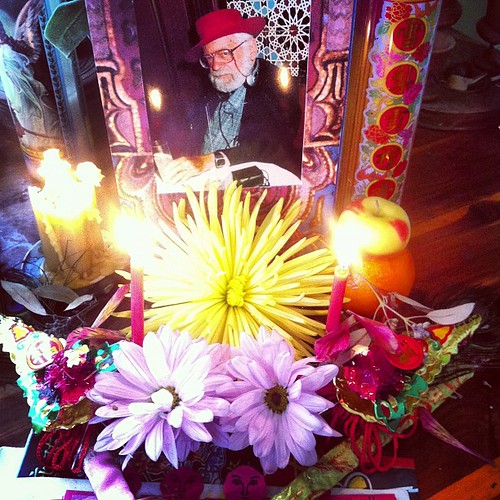
99th birthday altar for my beloved Grampa.
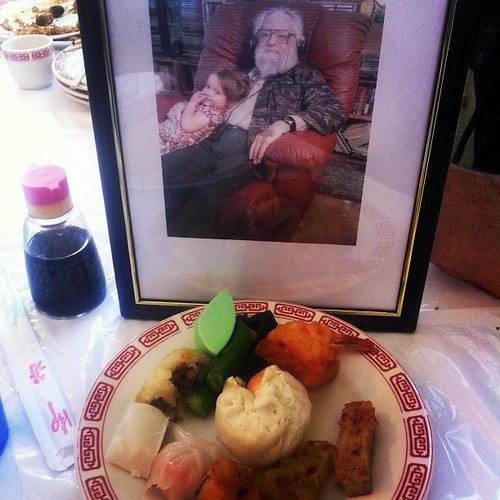
Memorial dim sum.
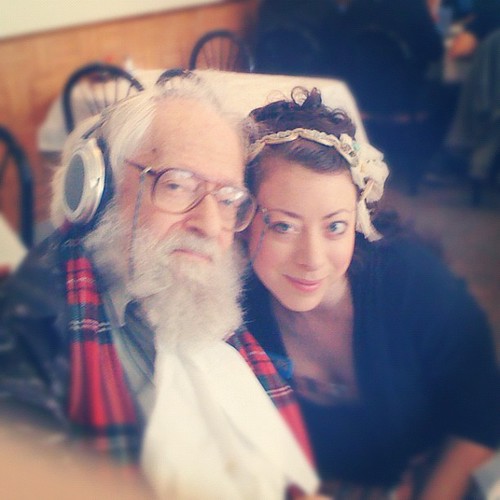
We always used to celebrate our birthdays together with a big family dim sum feast…
It was so strange gathering this year without him.
R.I.P. Charles Lessing Polacheck
January 19th, 1914 – February 27th, 2012
My father set The funeral song from Shakespeare’s Cymbeline to music, and sang it at the memorial last year.
At some point I’d like to record his version of that and share it here as well, but for now, here are the powerful words:
Fear no more the heat o’ the sun,
Nor the furious winter’s rages;
Thou thy worldly task hast done,
Home art gone, and ta’en thy wages:
Golden lads and girls all must,
As chimney-sweepers, come to dust.
Fear no more the frown o’ the great;
Thou art past the tyrant’s stroke;
Care no more to clothe and eat;
To thee the reed is as the oak:
The sceptre, learning, physic, must
All follow this, and come to dust.
Fear no more the lightning flash,
Nor the all-dreaded thunder-stone;
Fear not slander, censure rash;
Thou hast finish’d joy and moan:
All lovers young, all lovers must
Consign to thee, and come to dust.
No exorciser harm thee!
Nor no witchcraft charm thee!
Ghost unlaid forbear thee!
Nothing ill come near thee!
Quiet consummation have;
And renowned be thy grave!
GOODNIGHT, GRAMPA
CHARLES LESSING POLACHECK, R.I.P.
WAVES
FULL SNOW MOON – SORROW AND KINDNESS
by angeliska on February 25, 2013
The Snow Moon of February is waxing, rising: also know as Storm Moon, Hunger Moon, Bony Moon and Little Famine Moon. In most places, this is the month of the heaviest snows, the harshest weather, and the hardest hunting. This was often a season of starvation, for the native people and animals in the North. Though it’s springtime here in the South, I know other places are still bitter cold, still blanketed under heavy folds of white ice. I don’t know what that’s like, but I have been sitting with this winter feeling, a frostbitten heart warmed back to beating by hot breath, soft mittens. I told the daffodil buds pushing shyly through the mulch that it was safe to raise their ruffled heads, that the time of frost and rime was done with. I hope I wasn’t lying. This year has cored me like an apple: taken all the parts of me that I thought were essential, and chewed them up, spit out the pips, left nothing but my stem and my skin. It was enough. I have a palmful of seeds to plant anew, I have my heart, I have this dirt. I came through slaughter, bloodied and broken, bowed. I came through. It’s taken a long time to write this. I began it when I was at my most shattered, and then shelved it for months when it was too raw, the pain too embarrassing. I felt tired of writing about my sorrow – though more than that, I felt tiresome. The fear got put in me, an arrow lodged between two ribs: the niggling doubt planted there, that what I chose to share was too much, too sad – wrong somehow. I stopped writing. I tried to write about only pretty things. I stopped. I was frozen in the middle of the road, gnawed on by the hungry scavengers, those wolves of the mind, that feast on your anxieties. In a long winter, the cold gets in your bones, it finds the drafts, the cracks in you, and it sucks the heat right out of your blood. That’s the way doubt works, too.
In the coldest months, the weakest animals in a pack get picked off, get left behind – eat or be eaten. You are either predator or you are prey. Your vulnerability is a liability, and fight or flight is the only choice. If you’re too tired to fight, and have nowhere to run, you just stop, freeze, forever. “The weak are meat the strong do eat.” Kill or be killed. A sacrificial lamb, a scapegoat, left desolate in the snow, the boot on your back, teeth at your throat, felled beneath a pitiless victor. The rapacious hunter whose hunger knows no bounds, so empty inside that no amount of flesh can fill a belly that’s just fur slung over bones. Hunger makes creatures cold-hearted and crazy, makes them turn against their own. This is the way of the world, the way of nature, I know. I can sit with it, I can look, and look and take it in. I won’t look away, but instead turn my gaze to the images that make my soul crumple, that speak to the bleak desolation of grief, the howling heart, alone in a vast landscape, crying in the bitter wind. Victims of severe frost, halted mid-motion by prisons of ice. O, innocents, wandering lost in the snow – death draws near with an icy scythe, to cut you down in one white instant. Winter is brutal, and all we can do is huddle together. The only way to survive is to help each other, to stay with your pack, to find your tribe. Our communities are all we have: our lovers, friends and family. The ones who keep you close, keep you warm at night. All we have is each other, so why do we hurt one another? Where does this capacity for cruelty come from? What is it that inspires kindness, the small acts of tenderness that make life possible even in the direst times? I’m coming to understand that our ability to experience grief and move through it can make us more kind, more compassionate to others. That awareness and empathy for suffering is what gives us the strength and love to extend compassion beyond ourselves. This can be a vicious world. Every act of grace and gentleness counts. Kindness changes everything. I’ve been rereading Cloud Atlas for the dozenth time, and have been thinking a lot about the themes that run through that beautiful book: of slavery and subordination, of the currents of love and bravery that triumph in the midst of the horrors we humans can inflict on each other.
“Our lives are not our own, we are bound to others, past and present. And by each crime and every kindness, we birth our future.”
I’ve also been delving into The Places That Scare You – A Guide to Fearlessness in Difficult Times, by Pema Chödrön recently, and finding much wisdom there. This book contains major teachings for me, and has given answers and solace in deep lessons that I feel I have been searching for for many years. The quote in the beginning of the book, and the explanation of bodhichitta pulled me in immediately:
Confess your hidden faults.
Approach what you find repulsive.
Help those you think you cannot help.
Anything you are attached to, let it go.
Go to the places that scare you.
– Advice from her teacher to the Tibetan Yogini Machig Labdrön
“An analogy for bodhichitta is the rawness of a broken heart. Sometimes this broken heart gives birth to anxiety and panic; sometimes to anger, resentment and blame. But under the hardness of that armor there is the tenderness of genuine sadness. This is our link with all those who have ever loved. This genuine heart of sadness can teach us great compassion. It can humble us when we’re arrogant and soften us when we are unkind. It awakens us when we prefer to sleep and pierces through our indifference. This continual ache of the heart is a blessing that when accepted fully can be shared with all.”
I read the chapter on cultivating compassion today, and it brought everything together for me so profoundly. Everything I’ve been struggling to write about for months is right here:
“For arousing compassion, the nineteenth-century yogi Patrul Rinpoche suggested imagining beings in torment — an animal about to be slaughtered, a person awaiting execution. To make it more immediate, he recommended imagining ourselves in their place. Particularly painful is his image of a mother with no arms watching as a raging river sweeps her child away. To contact the suffering of another being fully and directly is as painful as being in that woman’s shoes. For most of us, even to consider such a thing is frightening. When we practice generating compassion, we can expect to experience our fear of pain. Compassion practice is daring. It involves learning to relax and allow ourselves to move gently toward what scares us. The trick to doing this is to stay with emotional distress without tightening into aversion, to let fear soften us rather than harden into resistance.
“It can be difficult to even think about beings in torment, let alone to act on their behalf. Recognizing this, we begin with a practice that is fairly easy. We cultivate bravery through making aspirations. We make the wish that all beings, including ourselves and those we dislike, be free of suffering and the root of suffering.
“We use the seven-step aspiration practice to soften our hearts and also to become more honest and forgiving about when and how we shut down. Without justifying or condemning ourselves, we do the courageous work of opening to suffering. This can be the pain that comes when we put up barriers or the pain of opening our heart to our own sorrow or that of another being. We learn as much about doing this from our failures as we do from our successes. In cultivating compassion we draw from the wholeness of our experience — our suffering, our empathy, as well as our cruelty and terror. It has to be this way. Compassion is not a relationship between the healer and the wounded. It’s a relationship between equals. Only when we know our own darkness well can we be present with the darkness of others. Compassion becomes real when we recognize our shared humanity.”
To Practice: Choose an image that enables you to contact the suffering of another. If you find this too difficult or painful, recognize the teaching in your response.
Many of the following images depict death and sorrow in a graphic and deeply affecting way. If pictures of dead animals or profound grief are upsetting to you, you may not want to continue, though I attest that they were not chosen gratuitously. I have kept some of these images archived for years, not fully understanding why I needed to look at them, why I needed to make myself feel so deeply for them. Now I understand. I hope you will, too. Also: I was unable to track down the original provenance for many of these images. If you are the source, or if you are aware of who made the image, please let me know and I will ascribe it rightfully.
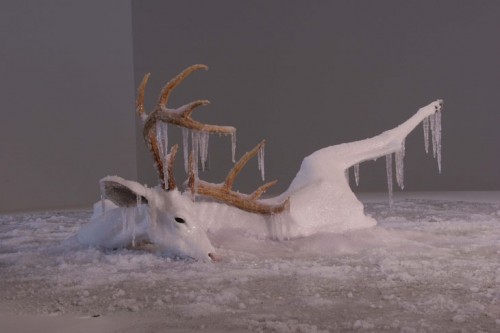
Untitled – Erick Swenson
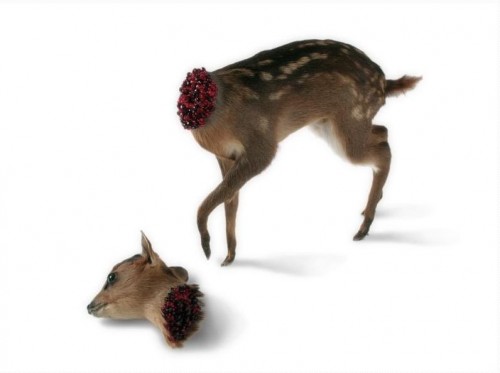
No Comment – Idiots
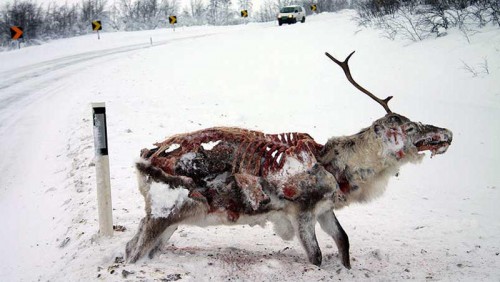
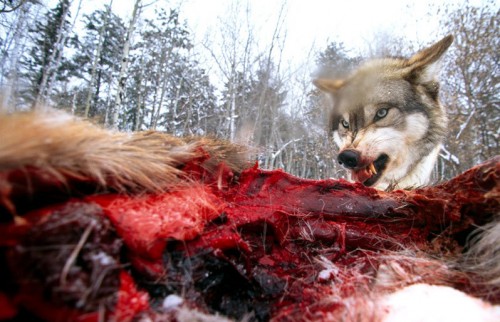
Snarling Wolf, Ely, Minnesota, 1998
“A remote-controlled “carcass cam” captures an inside view of a gray wolf fiercely guarding its meal at the International Wolf Center in Ely, Minnesota. Wolves at the center are provided with food, but wild populations generally hunt in packs. After a large kill, a single wolf can consume more than 20 pounds of meat.”


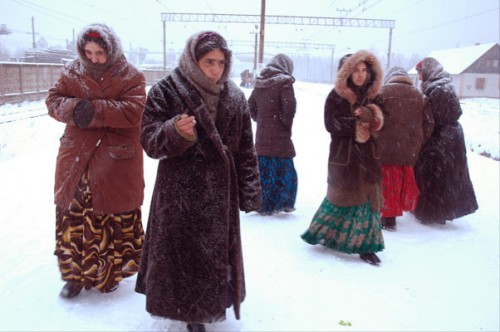

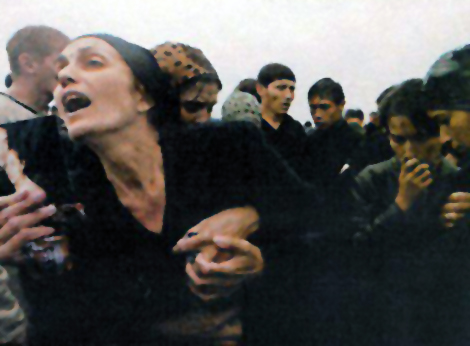
Yuri Kozyrev – Beslan, North Ossetia Sept. 5, 2004
I wish I could find a clearer version of this one. Somewhere I still have the scrap of the original cut out from a magazine when the tragedy at the Beslan school happened. I meditated on the pain and longing of the woman in the photo every day for a long time. Every fiber in her being outstretched, seeking her lost beloved one. The empathy and sorrow of the people surrounding her. The hands holding hers. The heart cries out.
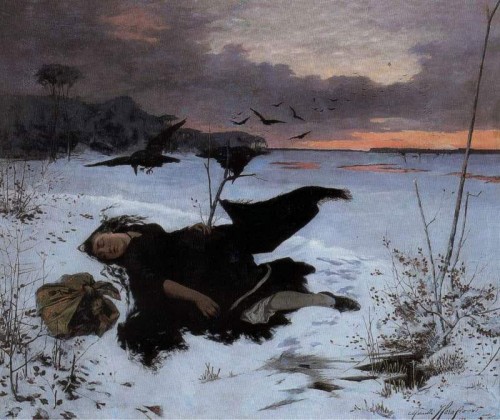
Marcel Harasimowicz – Zdobycz kruków (Prey Of Ravens), 1888
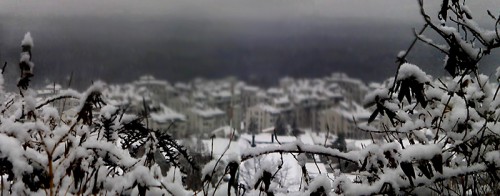

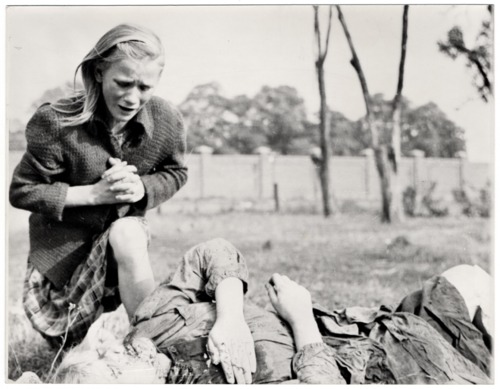
“Kazimiera Mika, a ten-year-old Polish girl, mourns the death of her older sister, who was killed in a field near Jana Ostroroga Street in Warsaw during a German air raid by the Luftwaffe.
“While I was photographing the bodies, a little ten-year old girl came running up and stood transfixed by one of the dead. The woman was her older sister. The child had never before seen death and couldn’t understand why her sister would not speak to her…
The child looked at us in bewilderment. I threw my arm about her and held her tightly, trying to comfort her. She cried. So did I and the two Polish officers who were with me…”
I had this photograph tacked up to the wall next to my bed all through my adolescence. Every night laying in bed I would look at it and feel so much love and sorrow for this girl grieving over the body of her sister. Even though I had not yet begun grieving my losses, I understood what it meant. I needed to look at it, at their faces.
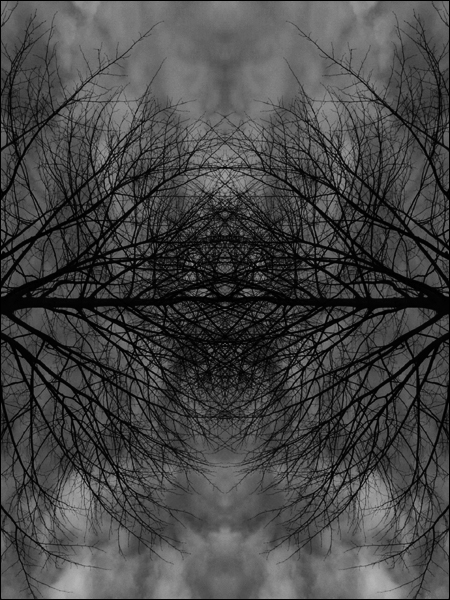
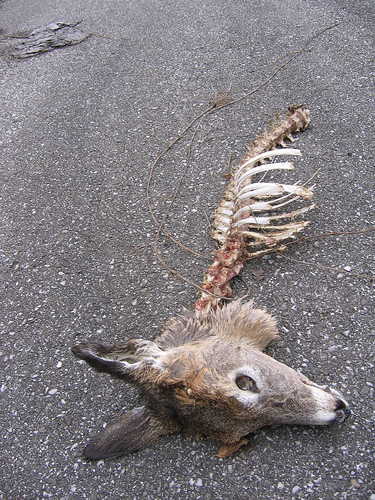


Photograph by Yuri Kozyrev
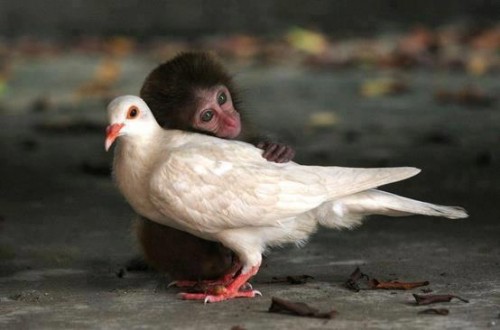
“An orphaned rhesus monkey and white dove that seemed to have lost its mate forged a special bond at the Neilingding Island-Futian National Nature Reserve in China. The monkey was born on the island but had strayed from its mother. Luckily, it was taken in by work staff in the protection center and became friends with the pigeon that had lingered there after possibly losing its mate.”
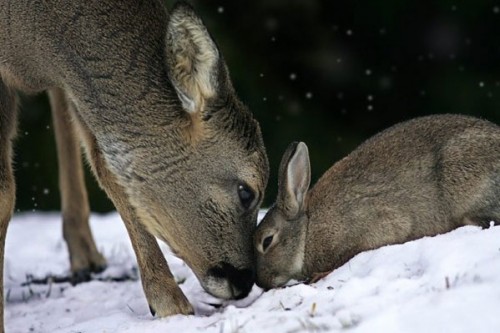
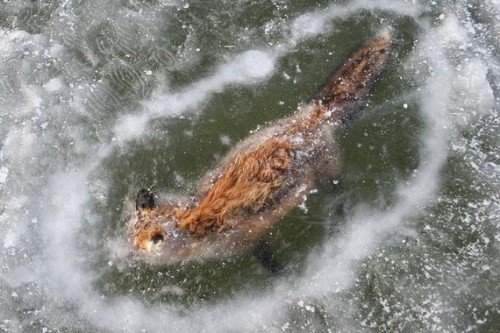



Photograph by Eugenio Recuenco
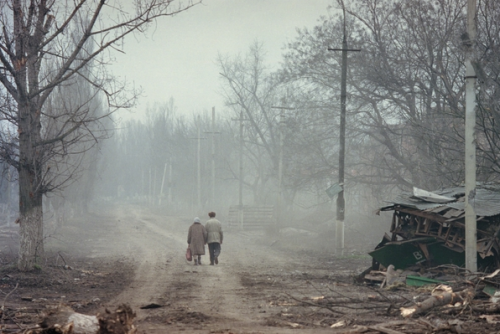
Photograph by Yuri Kozyrev
Kindness
Before you know what kindness really is
you must lose things,
feel the future dissolve in a moment
like salt in a weakened broth.
What you held in your hand,
what you counted and carefully saved,
all this must go so you know
how desolate the landscape can be
between the regions of kindness.
How you ride and ride
thinking the bus will never stop,
the passengers eating maize and chicken
will stare out the window forever.
Before you learn the tender gravity of kindness,
you must travel where the Indian in a white poncho
lies dead by the side of the road.
You must see how this could be you,
how he too was someone
who journeyed through the night with plans
and the simple breath that kept him alive.
Before you know kindness as the deepest thing inside,
you must know sorrow as the other deepest thing.
You must wake up with sorrow.
You must speak to it till your voice
catches the thread of all sorrows
and you see the size of the cloth.
Then it is only kindness that makes sense anymore,
only kindness that ties your shoes
and sends you out into the day to mail letters and
purchase bread,
only kindness that raises its head
from the crowd of the world to say
it is I you have been looking for,
and then goes with you every where
like a shadow or a friend.
– KINDNESS
by Naomi Shihab Nye
from The Words Under the Words: Selected Poems
The full Snow Moon in Virgo challenges us to release ourselves and others from judgement, from the critical mind that seeks to find fault, lay blame. We are all imperfect, fallible, messy beings. We make mistakes, we hurt one another, consciously or blindly. We are all doing the very best we can. This full moon I seek to open my heart up to true acceptance and forgiveness, for myself and others, and to let go of all my resentments, frustrations and grudges. They have been a very heavy burden. I don’t want them anymore. They do not serve me well. I am ready for peace. This is a time for healing. The Moon in Virgo opposing Chiron, The Wounded Healer, activates and shines a light on doing this work first in your own heart, and then with an eye towards service and helping others. The lesson I have been given recently is to make myself “incapable of disappointment” – in order to do that, I must give permission to all things to be exactly as they are. This is hard work, and I am trying. Snow Moon, help me to be kinder, gentler and more patient – to myself as well as others.
“Judge nothing, you will be happy. Forgive everything, you will be happier. Love everything, you will be happiest.” – Sri Chinmoy
“Three things in human life are important: the first is to be kind; the second is to be kind; and the third is to be kind.” – Henry James
FULL SNOW MOON IN VIRGO
Full Moon in Virgo: Into the Dark Woods
You do not have to be good.
You do not have to walk on your knees
For a hundred miles through the desert, repenting.
You only have to let the soft animal of your body
love what it loves.
Tell me about your despair, yours, and I will tell you mine.
Meanwhile the world goes on.
Meanwhile the sun and the clear pebbles of the rain
are moving across the landscapes,
over the prairies and the deep trees,
the mountains and the rivers.
Meanwhile the wild geese, high in the clean blue air,
are heading home again.
Whoever you are, no matter how lonely,
the world offers itself to your imagination,
calls to you like the wild geese, harsh and exciting —
over and over announcing your place
in the family of things.
– Mary Oliver
All On a Mardi Gras Day
by angeliska on February 23, 2013
I’m still slowly editing all my photos from Mardi Gras, so in lieu of a much belated post from me, I wanted to share a peek into the magic of that day while the memories are still fresh, and the music is still echoing in my mind… It was a grey, drizzly day, but it only dumped down on us once or twice, and the Indians made it out after all. New Orleans photographer and sculptor Christopher Porché West of A Studio On Desire captured so many wonderful images of my beautiful friends and beloved strangers on my favorite day of the year, I felt moved to show some of the ones that I loved the most here. His photographs really serve as a beautiful reminder that Mardi Gras morning is for everyone – regardless of their age, race, gender et cetera. I think it’s really what I love most about that celebration: that you see old ladies shimmying down the street with old men dressed as old ladies, and families with kids in wagons, tiny babies cradled lovingly by their beastly-bedecked mamas, mariachis, strange bejeweled birds, and all people who haven’t slept in days debauching extravagantly past the front stoops of those who chose not to masque, but peer curiously out their front doors at the revelry in the street. All on a Mardi Gras Day. It is so, so beautiful. There is truly nothing else like it.

Mardi Gras morning starts with the Skull & Bone Gangs clattering and banging on trashcan lids with bloody cow femurs, making a frightful racket to wake up the living for the big day of misrule and wildness. I’m always occupied with my costuming, so I’ve never seen the bone boys doing their thing at dawn, but maybe one year they’ll come bang on my door, saying, “Wake up, wake up, do not be late. It’s Mardi Gras Morning. Go celebrate! Young and old got to go. Make your move to change your life now, or else you will become like me. YOU NEXT!”
THE SKULL AND BONE GANG WAKES YOU UP ON MARDI GRAS DAY…
Skull and Bones Gang channels spirit of Mardi Gras
If the Bone Gangs get you up and at ’em, you can go out and chase some Mardi Gras Indians, first thing. This year the Young Seminole Hunters were looking very pretty indeed. Don’t know what that’s all about? Check out this piece I wrote a few years back: Who are the Mardi Gras Indians?




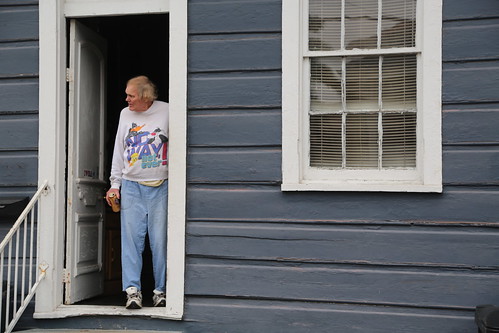
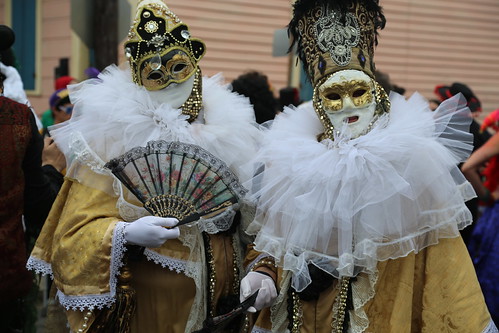
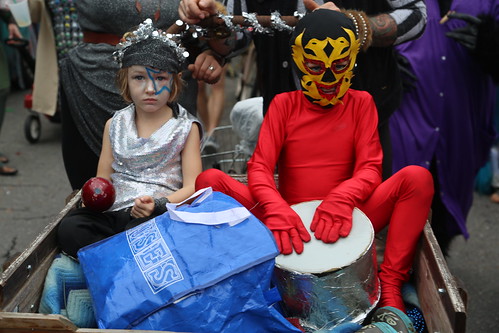
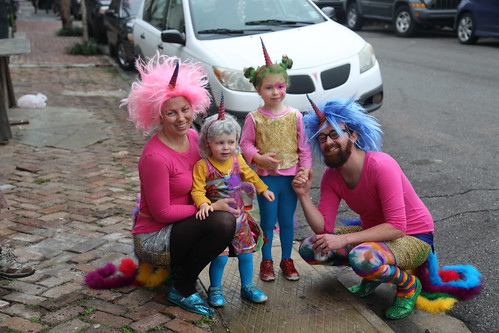
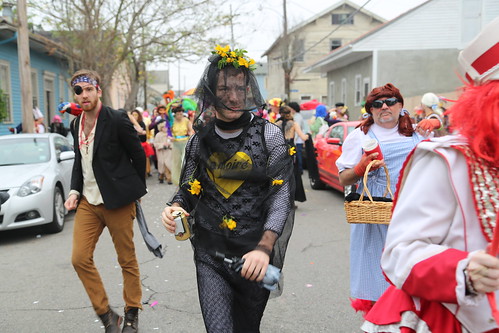
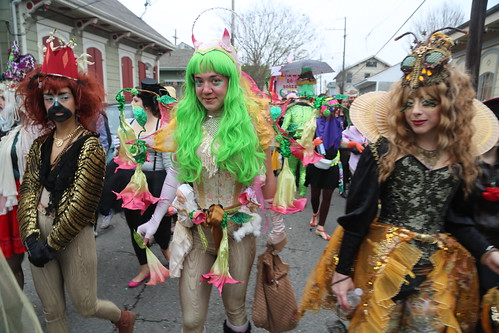
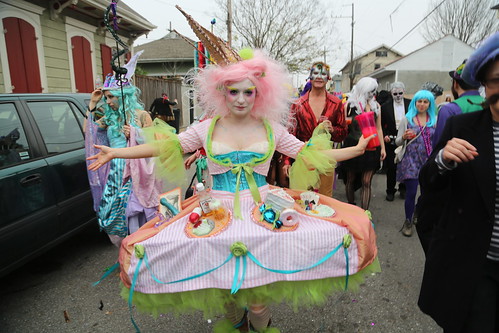


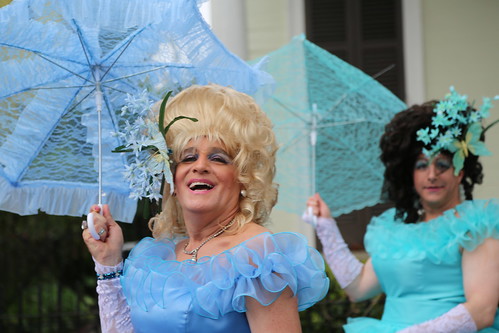


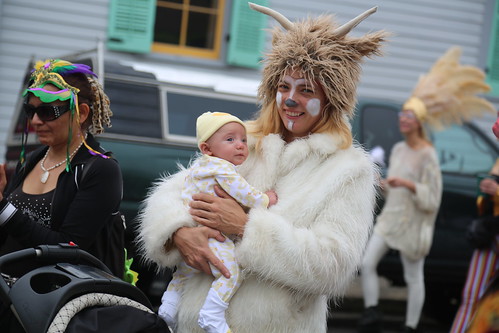

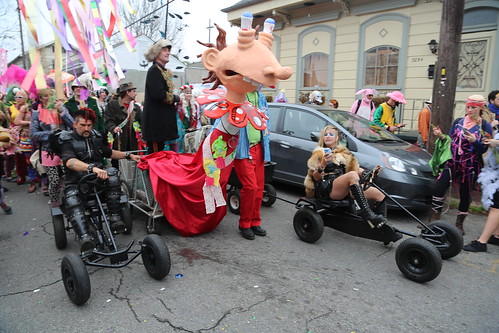
Here’s the full set of Porché West’s Mardi Gras 2013 photographs.
Some of his most amazing work can be seen here, and here also:
NEW ORLEANS COLOR
“Mardi Gras Skeletons” Royce Osborn
Dr. John, the Night Tripper – Mardi gras day
MARDI GRAS DAYS OF YORE – CIRCA 2009
by angeliska on February 6, 2013
I’m opening a time capsule into a Mardi Gras day of yore that I never got around to writing about – I have a few of those stowed away in my dusty attic of an archive, and it’s just not right. It always seems strange to write about it when the season isn’t upon me, so I wait and stash these caches of jewel-like memories from my favorite holiday away until another Carnival season takes me by surprise. I’m going to do my best to share more of them here, because they really are so special, and I honestly can’t really think of anything else right now.
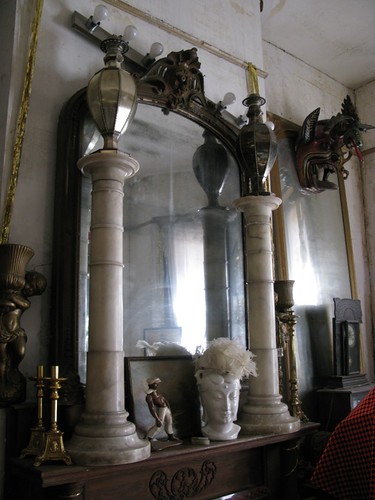
Fat Tuesday morning dawns in a flurry of last minute costuming: bustles being strapped on and wigs pinned down tight before heading over to Clouet St. where the Krewe of Sainte Anne has traditionally gathered. Marcus Fraser is an antique dealer (and owner of Le Garage) who has opened his exquisitely appointed home and magical garden to the revelers to meet up at before parading forth into the bright day. There is no better backdrop to photograph your costumes in first thing (before the threat of anything going awry or major fashion malfunctions have the chance to strike!)

A remnant from yellow fever days…
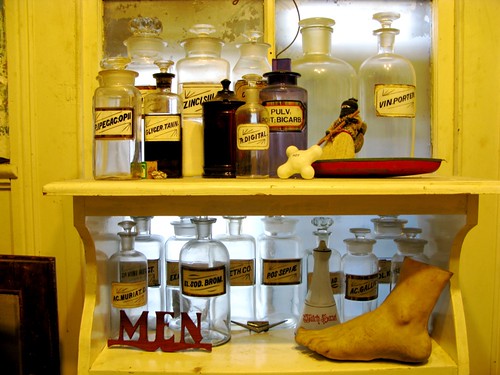
The lavatory was decorated with an amazing collection of medical antiques long before that theme came into vogue…
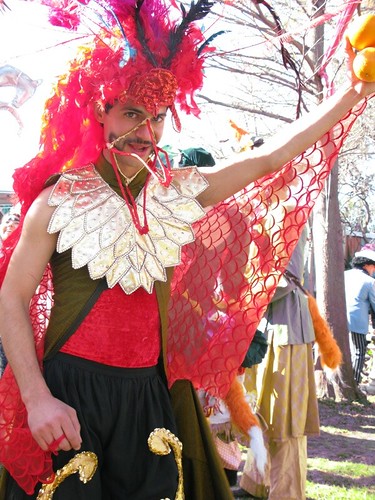
Mateo Hinojosa as a splendiferous phoenix.
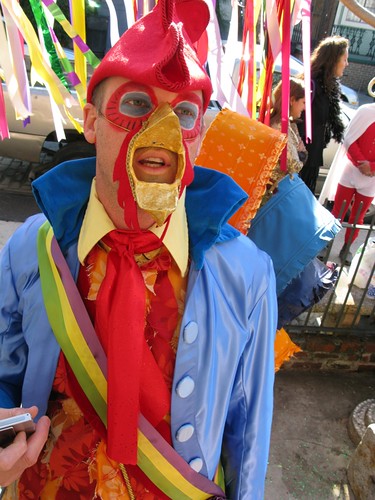
Jonathan Straus in his fabulous rooster costume
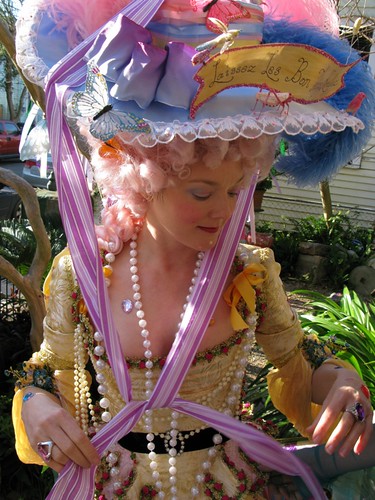
Jenny Singsaas-Straus as a Mardi Gras Marie Antoinette
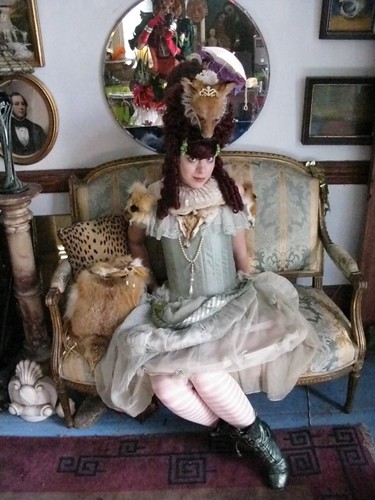
I was an Elizabethan Kitsune Queen!
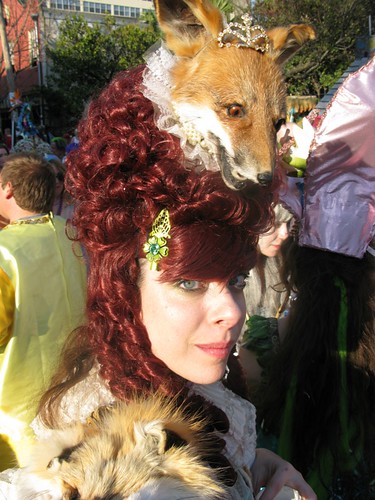
Attaching a Victorian taxidermy fox head to a wig was quite a feat of engineering, I must admit.
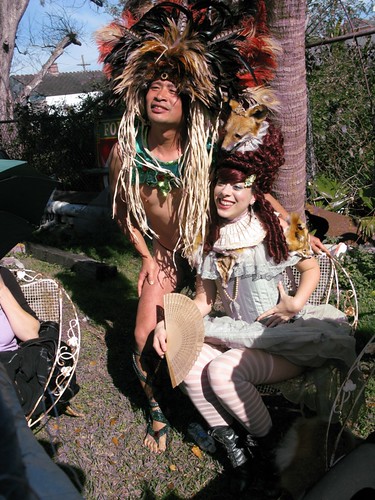
Gordon was visiting from Taiwan – he surprised and amazed us all with his Amazonian dancer ensemble!
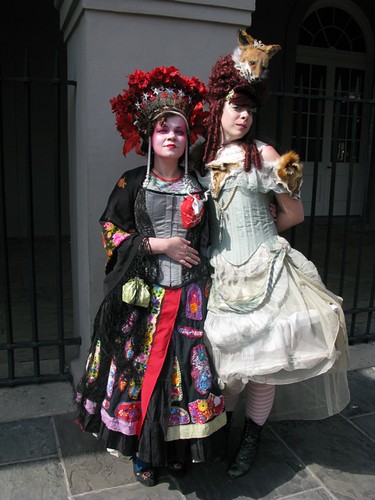
Miss Angie designed her gorgeous costume on the Taiwanese aboriginal story of the girl who fell in love with a stag.
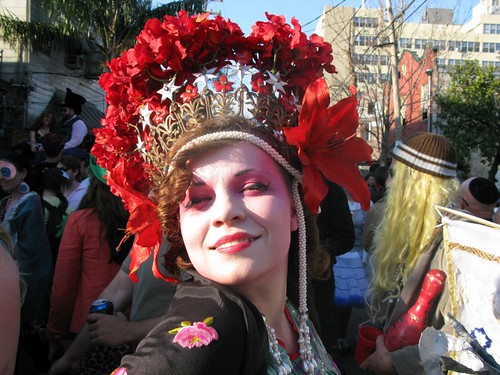
She is so beautiful!
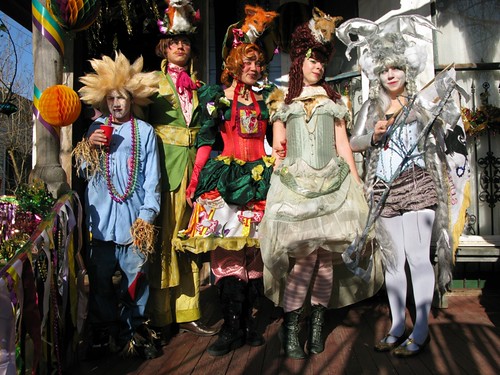
Gathered together before heading out into the fray…
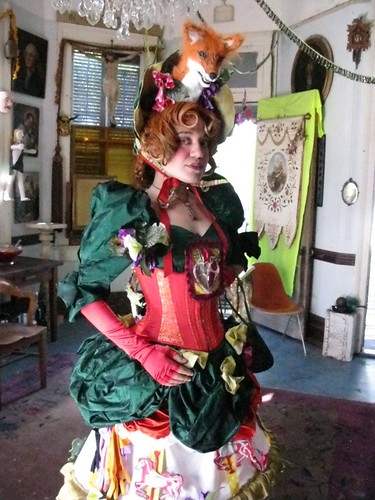
Perfection!

Miss Foxglove

Mr. Foxglove
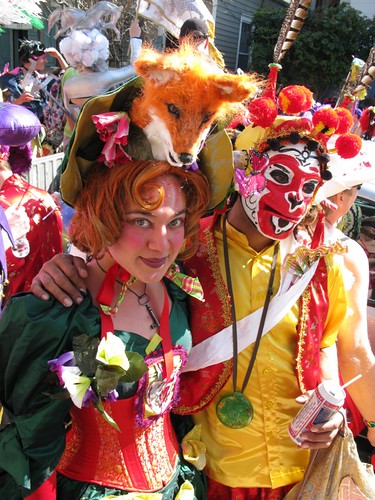
Pandora Foxglove and Lester as Hanuman
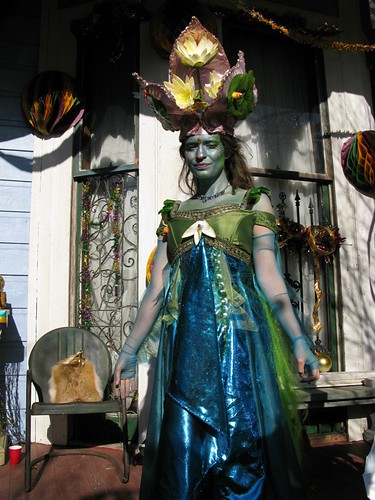
Raven was a pond sprite water spirit
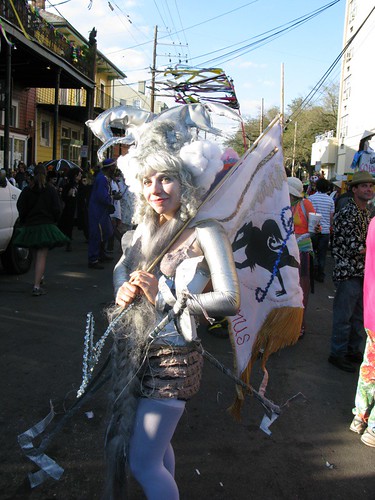
Nina was a weathervane
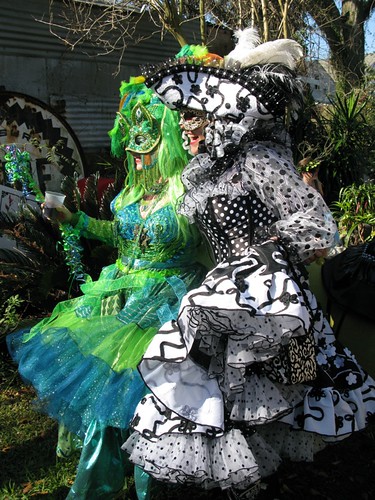
Incredible revelers
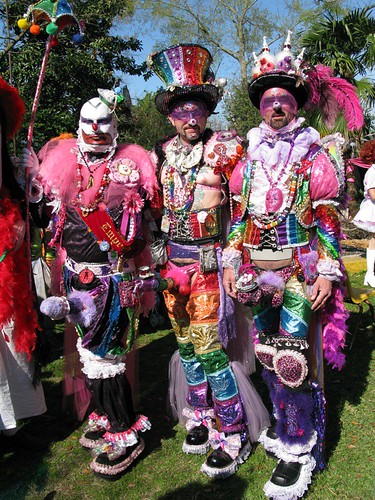
Salamander and his krewe of rainbow sex-clowns
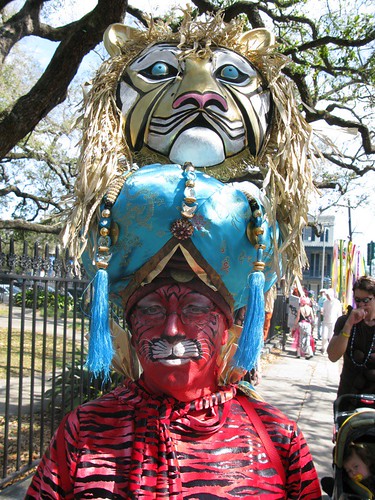
Andrea the Tiger Prince
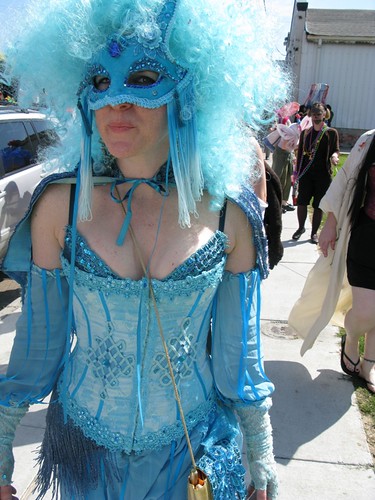
Crystal Blue Persuasion!
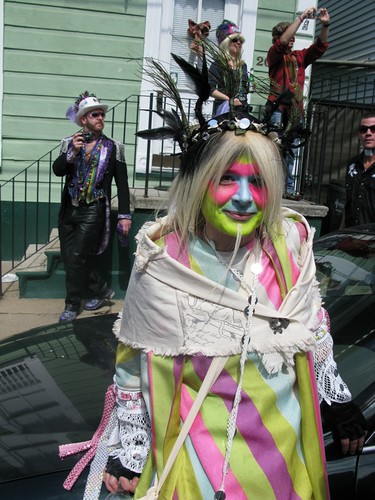
This little goatee lady was one of my favorites… I don’t know who she is, though!
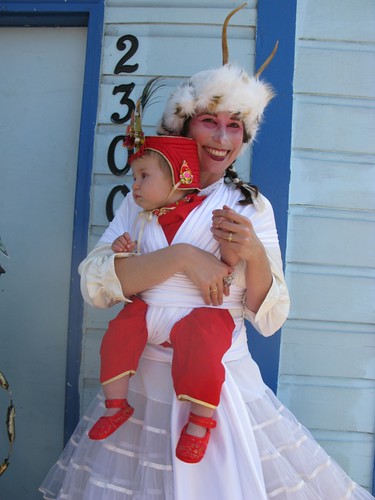
Marcela and baby Ruby!

Possum Man!
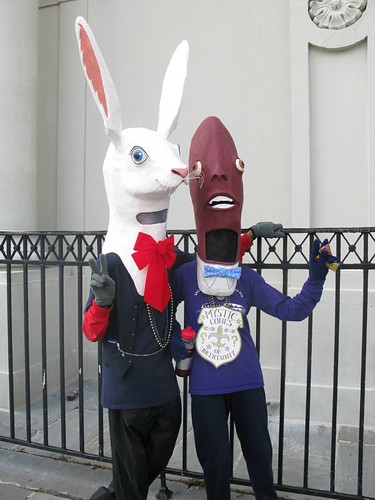
A bunny and a bean!
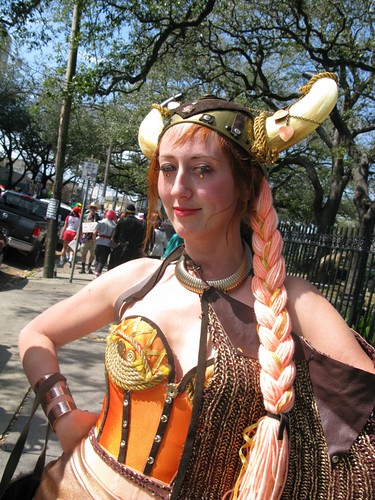
Allyson Garro as an electric Valkyrie
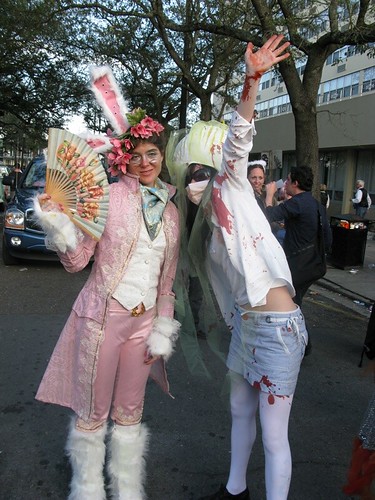
A cute bunny and someone bloody
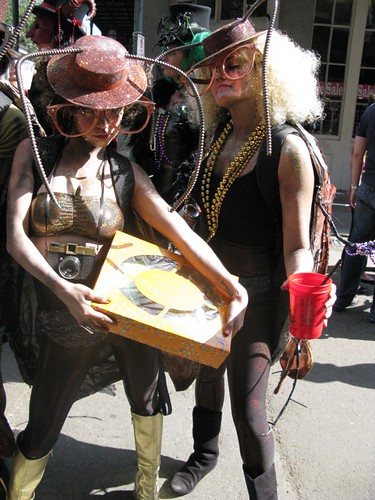
Those cute cockroaches got a king cake!
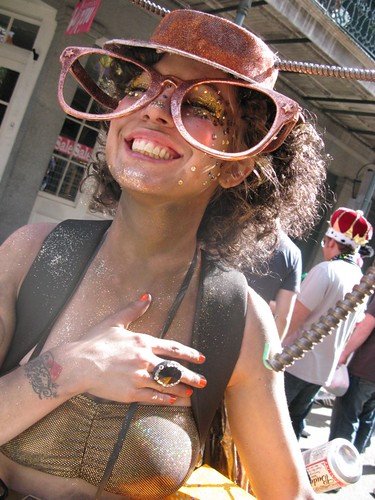
Only Jamie Gandy could make a palmetto bug into something cute!
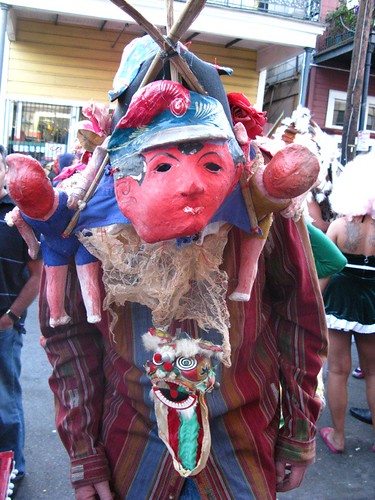
Who’s that under there?
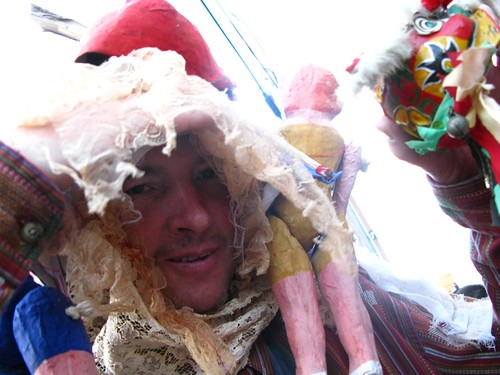
It’s Mr. Shade!
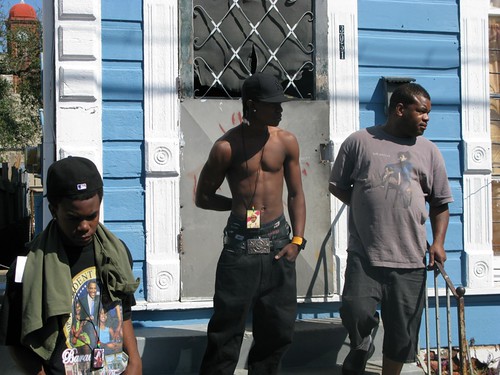
Watching the parade go by on Royal St.
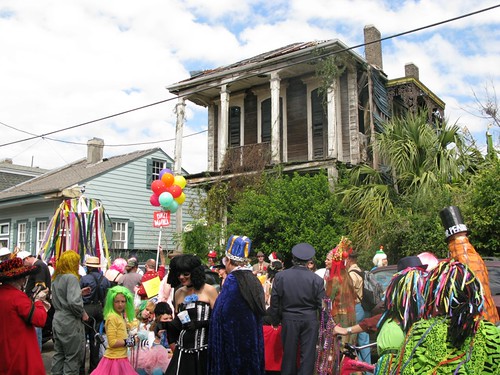
Saint Anne processes onward…

A random grafitti wall popped up in the middle of the street.
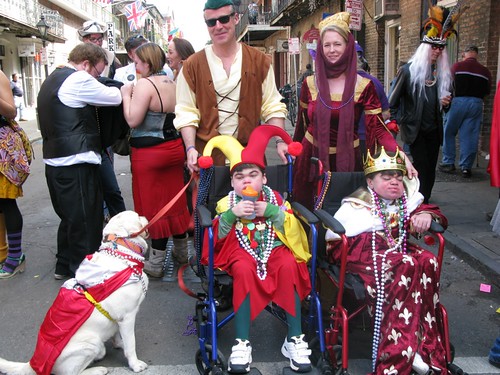
Family portrait
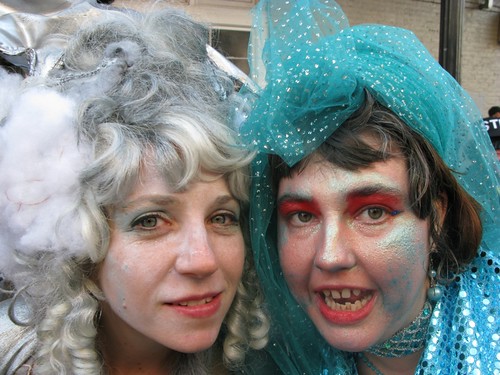
Loveys
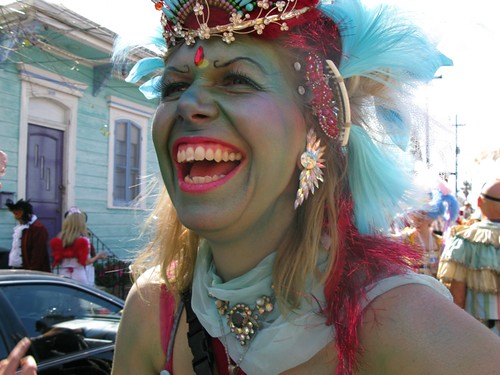
Shannon Brinkman
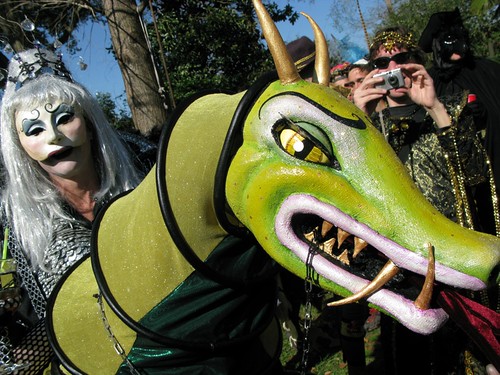
This articulated dragon was truly mind-blowing…
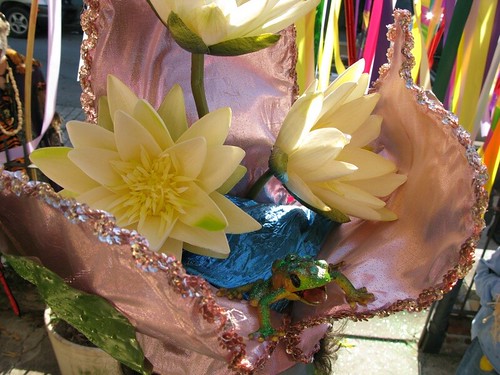
Raven’s waterlily crown from above
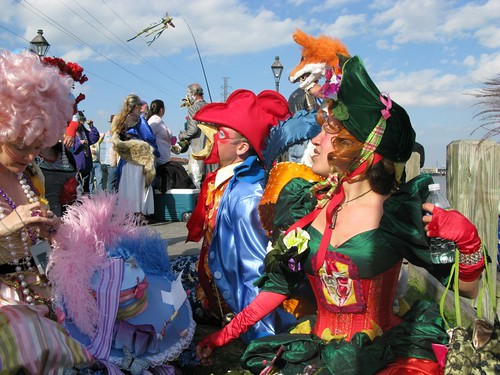
Down by the riverside…
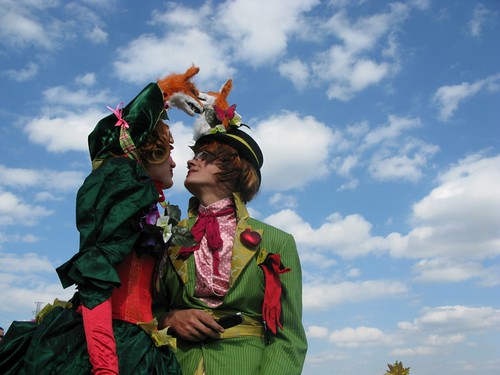
Foxes whispering sweet nothings

On Mardi Gras day, you see so many magical things – like a beautiful rooster perched on a sidecar down on Chartres St.
My full set of photos from the day can be found here: Mardi Gras 2009
I also had the honor of being featured in National Geographic Traveler Magazine’s article about Mardi Gras I need to sit down and scan the original issue, but here’s the Dutch version:
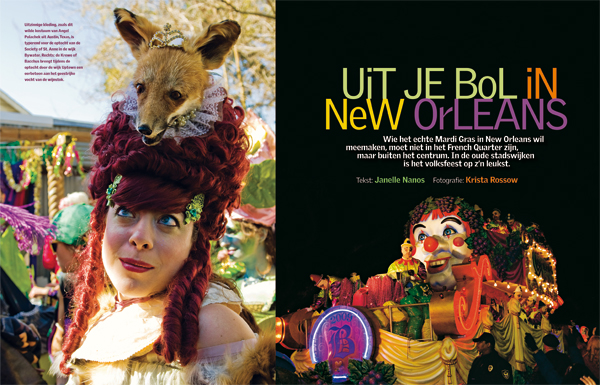
Photograph by Krista Rossow
Here’s an excerpt from the article by Janelle Nanos, from the January/February 2010 issue of National Geographic Traveler:
My bearings are off. It feels as if I’m in a maze of fun house mirrors. I’m standing at an intersection in New Orleans and before me is a blue-skinned Vishnu, the Hindu protector of the universe, none of whose many eel-like arms seems to point me in the right direction. Behind me, a rooster crows. I turn and realize it’s a man wearing a gold beak and blood-red cockscomb. Above, ribbons dance like spotlights against a bright blue sky, and people perched on wrought-iron balconies flap their arms like sparrows. A masked woman—or is it a man?—rides by on a dragon. This is Mardi Gras? I wonder. It seems like an alternate universe.
This parade—put on by the Society of St. Anne—is not the boozy, Bourbon Street Mardi Gras you hear so much about. It’s an unofficial event held in the Bywater, a bohemian enclave—one of 16 distinct neighborhoods in the Crescent City—that’s a world apart from the throngs in the French Quarter.

“Laissez les bon temps roulez,” reads Marie Antoinette’s hat. Jenny Singsaas of Burbank, California, has made her costume for the five years that she has attended the Society of St. Anne parade. “The most wonderful thing happens on that Tuesday,” says Singsaas. “There are people you only see once a year, that day, in costume, but you recognize each other and are great friends.”

Wandering into Marcus Fraser’s backyard in the Bywater neighborhood on Mardi Gras morning is a little like falling down the rabbit hole. Costumed revelers mill about, catching up with friends and complimenting each other’s elaborate ensembles before the Society of St. Anne parade begins to wander down Royal Street towards the French Quarter.
And finally, some videos from the day from Jenny Singsaas-Straus + Jonathan Straus of House of Straus:
This little dog named Underfoot was trying to fight my fox head. He was so confused by it!
Frenchmen St. – Mardi Gras Afternoon
“Things to note in this video: Angeliska & Underfoot obviously – what lovers. Adorable Pandora, nuff said. I’m starting to feel my alcohol as my laugh has morphed into a chicken cluck & brawwwwk and I’m unconsciously moving like a chicken to whatever music is playing. Jenny caught James spanking people with his fox’s gloves – which he giddily discovered and then undertook as a civic service to everyone who passed. And lastly the gorilla that first notices the camera and then apes for it. No video is complete without a gorilla. “Qui pe resist un gorille?”
Go, go, go, you hot struttin’ coq!
Perchta
by angeliska on January 6, 2013
Pandora Gastelum of The Mudlark Confectionary and The Mudlark Public Theatre lovingly created this incredible art doll of the Two-Faced Goddess Perchta for my birthday last year, and I’ve been meaning to share both images of her creation and her story ever since:
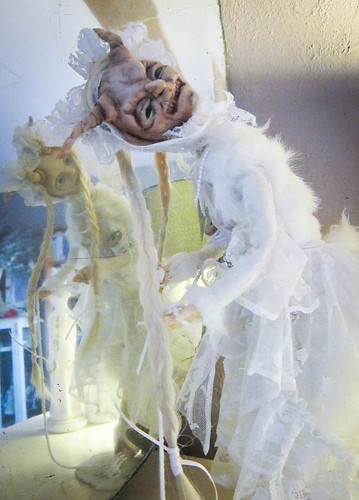
Perchta – Derived from an early Germanic word meaning “bright or “glorious”. Perchta is famed for her dual nature. Her grim aspect is known as “Perchta the Belly Slitter”. Perchta is alternately described as kind or violent, as a monstrous hag or a willowy maiden.
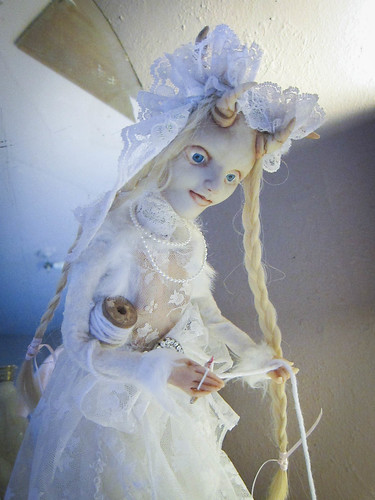
Perchta is typically veiled and clothed in white and is often portrayed with the horns, shaggy fur and hooves of a goat. The Medieval Church wrote of “sinners” who would leave food for Perchta in the “Night of Perchta” to obtain prosperity and well being in the coming year, as well as commanding the people to surrender their belief in “Frawen Percht”, and complaining of locals who would rather chant of “Domina Perchta” than say their prayers to the Virgin Mary.
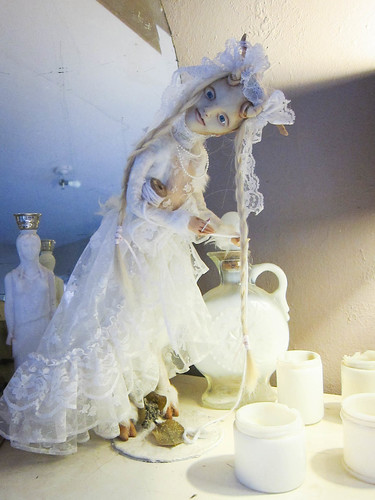
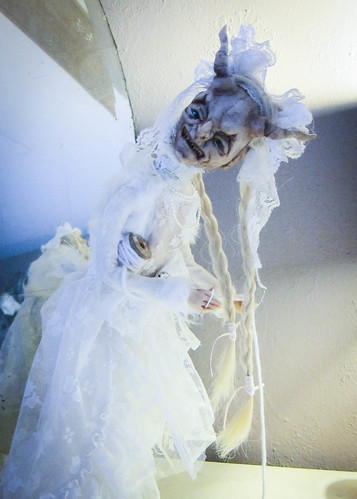
Perchta is associated with the spindle and with spinning. When the shepherds brought flax to her in the summer, she blessed their flocks, and they would often see her walking along the steepest slopes around twilight, with a golden spindle in her hand. The spindle is strongly associated with fate and fortune and is central to traditions of girls’ puberty initiations. Perchta oversees the timely completion of the season’s spinning – if you don’t get it done on time, Perchta might curse you with bad luck in the next year, or even cut open your stomach, pull out your entrails, and refill you with rubbish!
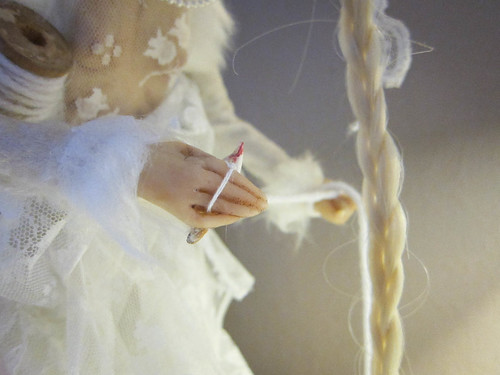
Perchta is associated with the Wild Hunt in folklore and is often said to be the one leading it. The Wild Hunt is held by the Forest Gods in the deep winter months, and may be dangerous to humans; being in the path of it can be deadly. Perchta’s victims are typically portrayed with their bowels trailing behind them. This symbolic evisceration implies a profound examination of the self.
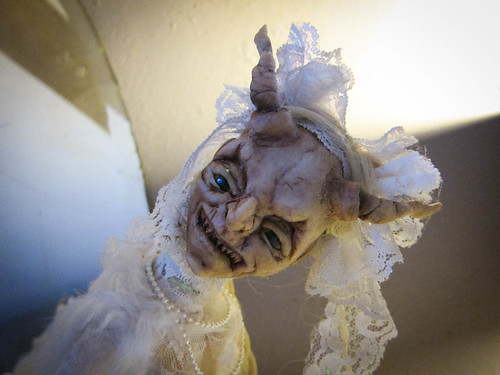
Perchta is a major figure in the winter holidays throughout the alpine world. She is widely held to be the female counterpart to the devilish Krampus, and will often accompany him on his hunt for naughty children on December 5th. Perchta is particularly associated with Epiphany, starting the night of January 5th and going on to January 6th. This holiday is sometimes referred to as “Perchtentag”, meaning Bright Day, Perchta’s Day, or Perchten’s Day.

“Perchtenlauf is an ancient Pre-Christian ritual where young men dress in costumes with frightening “Perchta masks” going from house to house frightening away the evil spirits of Winter that wander the countryside seeking to harm humans. This procession was traditionally done on the winter solstice. This is the longest night of the year where the sun shines the least. It is also the beginning of when the Sun begins its return trip and shines for longer periods bringing the warmth of Spring. Perchta was summoned on this night to frighten away the long cold winter and make room for the brightness of spring. Hundreds of years ago when the threat of death during the cold winter months was very real for the Teutonic tribes people, it was necessary for people to be given hope of the coming spring. Perchta was the goddess who fought back against the darkness of winter not only in the external world but in the hearts of humans. The ritual of Perchtenlauf no doubt has roots extending into pre-historic ice age shamanic rituals of the proto-Teutonic people. Surprisingly, the ritual of Perchtenlauf has been continuously practiced in the Alps up until the present.
Perchta shows dual faces at this time. To the faithful, she appears as a beautiful goddess of light who blesses humans with health and prosperity. To the evil hearted, deceitful and wicked, she appears as a ferocious demon with horns and fangs. In this depiction, she is strikingly similar to the east Indian goddess Durga who alternately appears as the nurturing mother of all and the frightening Kali Ma who devours demons and drinks their blood.”
– From Perchta: Protective Goddess of Light and Dark by Thunderwizard
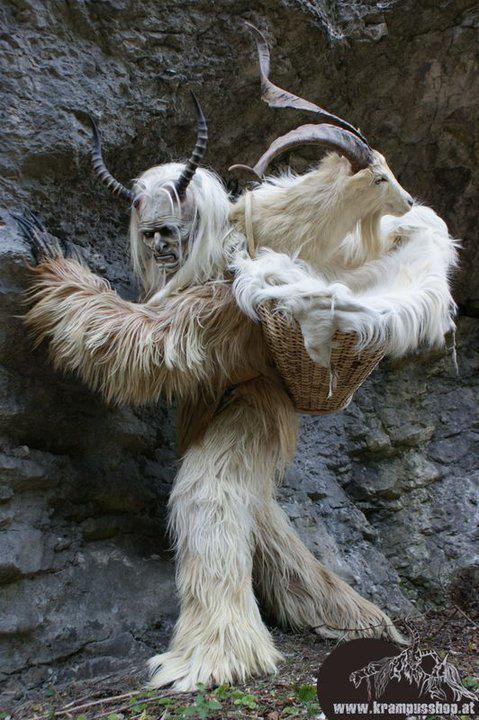
…”the Krampus was believed by alpine Germans and Austrians to accompany Saint Nicholas on his rounds, but rather than just stuffing lumps of coal in a naughty child’s stocking, the Krampus – who, by the way, was depicted as a very tall, very shaggy, goat-like man — would inflict corporal punishment on the boy or girl with a cluster of sticks. If the child was particularly naughty, he or she would simply be thrust into a basket and taken away, one supposes, to whatever horrible place the creature came from — a place we can be quite sure was not Christmastown. Such a fate must have been one of the more effective threats leveled on a badly-behaved medieval child by his angry parents. Better than the ‘no presents’ approach, certainly. (Although in fairness, one must wonder exactly what presents a poor village child would have been expecting. Perhaps imagining terrible punishment from an other-worldly goat creature, and the avoiding of the same through good behaviour, was simply a natural anthropological response to having no upside at Christmas.)
Unfortunately, surviving the time of the Krampus would not get your family off the hook for the season, for it was also believed that during the twelve days following Christmas, a goddess would make her rounds of the countryside, inspecting homes and spinning rooms for any signs of disorder or laziness. This was, to the northern Germans, Frau Holda, an almost entirely benevolent divine being who taught humans the household arts of spinning, weaving, and reaping, but who was no softy: she was believed to ride with Wotan’s ghostly army (into which host the spirits of unbaptized infants were incorporated when they died), and was fond of setting on fire the spinning distaffs of any girls she thought had been unproductive and slothful that year.
Frau Holda‘s wrath, however, was mild compared with that of Perchta, the south German variant of the same goddess. On her festival day, she expected celebrants to eat only fish and gruel, which was considered fasting fare. The penalty for failing to do so, wrote Jacob Grimm in his Teutonic Myths, was ghastly: ‘whoever has partaken of other food on her day, she cuts his belly open, fills it with chopped straw, and sews up the gash with a ploughshare for a needle and an iron chain by way of thread’. In Swabia, her role was believed to similar to that of the Krampus – though more lethal — as ‘with hair all shaggy she walks round the houses at night, and tears the bad boys to pieces.’”
– From In the bleak midwinter, an excellent article by I. Garrick Mason at sans everything
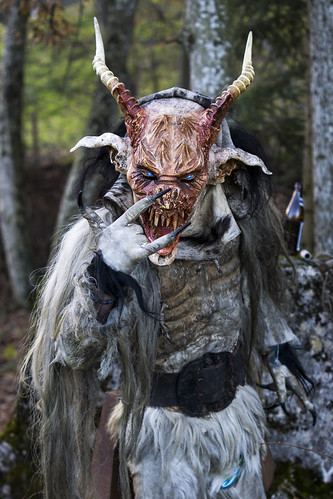
By s.stegh

From CRUSHEVIL:
Masked figures from the ‘Wilde Jagd’ Christmas folklore festivity in Salzburg, Austria. These festivities originate through the Perchtenlaufen custom, a period when the fearsome witch Perchta, who envies happily married couples, roams the villages. Processions of horribly masked figures armed with sticks and clubs meet throughout the festivity to chase the witch away.”
This picture is from Masks, Face Coverings and headgear by Norman Laliberté and Alex Mogelon
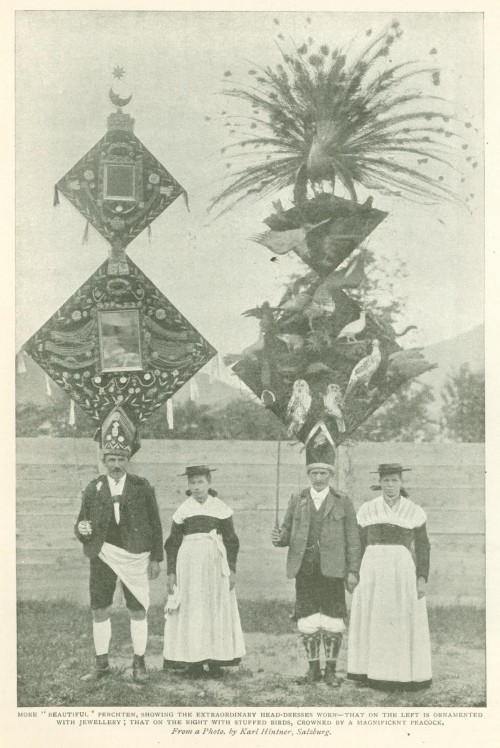
These headdresses are maybe the most captivating examples of folk ritual costume I have seen – in a long time. I would love to see them in person, in color. There’s got to be some crazy alpine museum in the mountains where some of them still exist, wouldn’t you think? I must find this place.
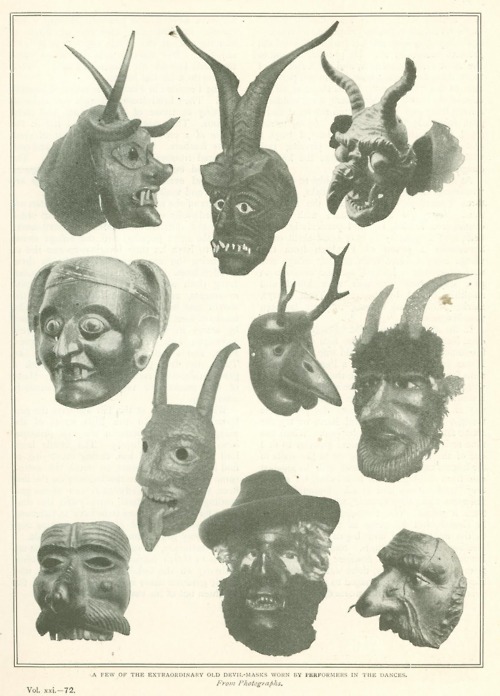
Some of the masks worn by Perchten Dancers of Salzburg.
I discovered this amazing article via the marvelous digital history project. It was originally published in the Wide World Magazine, September 1908. I’m reposting an excerpt here, but the whole thing really is just too fascinating, so please do go read all about it.
The Perchten Dancers of Salzburg Austria Tyrol Pinzgau
By MRS. HERBERT VIVIAN.
Amongst the mountains of the little Austrian Duchy of Salzburg dwell peasants who still mingle religion and mythology in a curious jumble and observe many remarkable customs. Perhaps the most extraordinary of their festivals is the Perchten dance, which is performed only at very infrequent intervals. Mrs. Vivian was fortunate enough to witness the latest celebration of this unique function and secure a set of striking photographs.
The Perchtentanz is named in honor of Perchta, another name for Holda or Freya, Woden’s consort and the mother of the gods. Although banished from many of her ancient haunts by rude civilization and unbelief she still clings to Salzburg and parts of the Tyrol, where the peasants not only believe in her, but fear her. Perchta means the Splendid, the Magnificent One. She may be seen, they say, wandering through the great fortress of Salzburg at dead of night. Towards the beginning of the year, in the guise of a tiny, wizened witch, with gleaming eyes, long hooked nose, and wildly tangled hair, she lurks at crossroads, waiting for travelers. When one approaches she greets him, with her friendliest smile, and holds out to him a black cloth. If he takes it he is done for, and will certainly not survive the year; but if he brings out his crucifix and says, “Dame Percht, Dame Percht, throw the cloth on the earth,” then every joy and blessing will come to his house.
If Perchta shows herself in a stable, sickness and death are sure to follow, unless the careful peasant hangs up a bunch of consecrated St. John’s wort, a potent herb in these lands. On other occasions the goddess gathers all the un-baptized children round her, and sweeps through the country at the head of the band. At Christmastime a spoonful of every dish used to be placed on a fence, or a gate, outside the house as an offering to this much dreaded lady. One of the strangest things about Perchta is that she has a double nature. Sometimes she is the soul of goodness and charity, at other times she is full of hate and malice to mankind. Men are fascinated by her, but their feelings are mixed, and fear is mingled with longing fear on account of her un-canniness, and longing because of her wondrous powers.
Perchta has her troops of followers, strange beings half-way between mortals and immortals, These do not live among the children of men, but appear amongst them at such times as Advent and the Feast of the Three Kings. Like Perchta herself, they are divided in disposition, for some are good, kindly creatures, such as the “beautiful” Perchten (Schiin Perchten); while. others, like the Schiachen Perchten, are wild, irresponsible, malicious things. They are more felt and heard than seen. In swarms they come down on men’s dwellings, and are recognized by their weird screams and laughter. They love to draw men into danger by alluring sounds and spells, and to punish undiscovered crimes. The Perchten dances originated among the peasants of the mountains, who desired to imitate these mythological beings, but of late years the performances have seldom been seen.
Presently there was a stir. The “beautiful” Perchten were arriving. Nothing could. be more fantastic than the appearance of these gentlemen. The pictures describe them far better than any words of mine can do. The lower part of their costume is unobtrusive, and all one’s attention is centered on their heads, which are crowned with what surely must be the most immense and eccentric head dress in the whole world. Two diamond. shaped boards, in all some ten or twelve feet high, are covered with red velvet. On them are fixed dozens of silver watches and chains and every kind of ornament the Perchten have been able to collect or borrow – looking glasses, artificial flowers, pictures of the Virgin, bracelets, necklaces, and coins. At the top comes a crown, above that a moon, and then again a star.
In their right hands the “beautiful” Perchten clasp a naked sword, and with the other they lead their partners – young men dressed as women. The latter were disguised so skillfully that it was almost impossible to tell whether they were really women or not, for of course there were many wives and daughters of the Perchten helping with the preparations. I remarked on this to my guide, so he immediately seized hold of the first person in woman’s garb he saw, and inquired:
“The English lady wants to know if you are a man or woman. Now, let’s hear which you really are.” As a matter of fact, the victim was a very shy girl; and there were blushes and giggles, accompanied by squeals of delight from the crowd.
The noblest of the “beautiful” Perchten wear bird head dresses. These are large pieces of moss covered board, and on them are fixed every rare bird that has been shot in the neighborhood by the Perchten and their friends. The “tafel,” as they are called, are really most striking and artistic. On the top comes a large bird with outspread wings, in this case a huge peacock with a gigantic tail. Naturally these head dresses are of a terrific weight; and have to be supported and steadied by an iron rod which is fastened to the back at the waist. I should think the poor fellows suffer for being beautiful, as the strain and the heavy load must conduce to violent headache. The back of the erection is usually covered with canvas and painted with a pastoral scene, such as the Almfahrt. A good part of the toilette of the Perchten had to be done in public, and it was rather amusing to see their wives fussing round them doing up buttons and tying strings.
This song isn’t really related to Perchta, and is Finnish rather than German, but I’ve become obsessed with learning it, and have been playing this entire album all through the winter holidays. It was only recently that I discovered the meaning of the lyrics, which are quite bleak. I love how happy and lilting this little lullaby is, only to have its deeper meaning revealed – if you can understand Finnish… A dual natured kantele seems fitting for Frau Perchta.
Eriskummainen kantele (The bizarre kantele)
Ne varsin valehtelevat, (Those indeed tell lies)
tuiki tyhjeä panevat, (are saying just empty words)
jotka soittoa sanovat, (those who judge the playing)
arvoavat kanteletta (claiming the kantele)
Väinämöisen veistämäksi, (being crafted by Väinämöinen)
Jumalan kuvoamaksi, (woven by the God)
hauin suuren hartioista, (out of a great pike’s shoulders)
veen koiran koukkuluista. (from the crooked bones of a water dog)
Soitto on suruista tehty, (But no, music is made from grief)
murehista muovaeltu: (and moulded from sorrow)
koppa päivistä kovista, (– its belly out of hard days)
emäpuu ikipoloista, (its soundboard from endless woes)
kielet kiusoista kerätty, (its strings gathered from torments)
naulat muista vastuksista. (and its pegs from other ills.)
Sentä ei soita kanteleeni, (Therefore my kantele will not play)
ei iloitse ensinkänä, (nor will rejoice at all)
soitto ei soita suosioksi, (music will not play to please)
laske ei laatuista iloa, (give off the right sort of joy)
kun on huolista kuvattu, (for it was fashioned from worries)
murehista muovaeltu. (moulded from sorrow)

